Running a digital marketing agency or any client-focused business can be costly, requiring numerous software tools and resources to meet client needs effectively. To ensure sustainability and reduce expenses, investing in the right client management software is a smart and practical solution.
Managing multiple client requests with a disorganized workflow can be overwhelming and stressful for your team. Worse, it can undermine client trust, reduce satisfaction, and even damage your agency’s reputation. The right client management software can eliminate these pain points, streamlining operations and giving you a competitive edge in the market.
But with so many options available, how do you choose the best solution for your business? In this guide, we’ll break down the key features and benefits of client management software and highlight the top 10 client management systems to help you make an informed decision. Let’s dive in!
Achieve maximum productivity by fulfilling all tasks in one place
What Is Client Management Software?
Client management software is like having a personal assistant for your business agency, working 24/7 to keep client relationships running smoothly. It’s a digital tool designed to help you organize, track, and nurture client interactions—all from one easy-to-use platform.
At its core, client management software is all about centralizing and streamlining. It brings together every piece of client information you need—contact details, project timelines, communication histories, and more—into a single, accessible hub.
But it doesn’t stop there. This software makes communication effortless, allowing your team to collaborate seamlessly with clients.
Whether it’s sharing updates, gathering feedback, or managing approvals, everything happens in one organized space. It even takes care of the mundane stuff, automating repetitive tasks like invoicing, follow-ups, and report generation.
How is this different from traditional CRM systems?
While client management software shares some features with customer relationship management (CRM) tools, the two serve different purposes.
CRM systems focus primarily on managing the sales pipeline—tracking leads, opportunities, and customer interactions to drive conversions.
In contrast, client management software is purpose-built for agencies and service-based businesses that need to deliver ongoing value to existing clients, not just close deals.
It focuses on operational efficiency, service delivery, client communication, and long-term relationship building.
What problems does client management software solve for businesses like yours?
For marketing agencies, franchises, and businesses supporting SMBs, client management software addresses the real-world challenges of scaling personalized service.
It eliminates data silos, reduces time spent on administrative tasks, and enables your team to deliver a seamless client experience across multiple touchpoints.
Whether you’re managing hundreds of local clients or juggling complex multi-location campaigns, it ensures no detail slips through the cracks, so your clients always feel supported, informed, and valued.
Why is this so critical for agencies?
Because delivering a consistent, tailored client experience isn’t just nice—it’s essential. When clients see that your team is always on top of things, responding quickly, and delivering exactly what they need, their trust in your agency grows. Satisfied clients don’t just stick around—they become your biggest advocates.
Agency management software transforms chaos into clarity, giving your agency the tools it needs to foster stronger client relationships while staying productive and efficient. It’s not just a tool—it’s the backbone of a modern, client-focused agency.
Check out this fascinating video about how an agency owner earns over $1 million a year effortlessly by leveraging agency management tools to streamline operations and automate tasks.
Benefits of Client Management Software for Agencies
Here’s how client management software can transform the way your team works:
1. Improved Organization and Efficiency
Ever feel like important details are slipping through the cracks? Client management software ensures that doesn’t happen by centralizing all client information.
Whether it’s project updates, contact details, or notes from the latest meeting, your team will have everything they need, exactly when they need it.
It also automates repetitive tasks—like scheduling follow-ups or sending out invoices—saving valuable time and reducing the risk of human error.
With less time spent on admin work, your team can focus on what truly matters: delivering exceptional service.
The result? Faster turnaround times, better internal coordination, and a significant reduction in missed deadlines and overlooked requests.
2. Stronger Client Relationships
Building meaningful client relationships requires a personal touch. With client management software, you can track communication histories, preferences, and past interactions to ensure every client feels valued and understood.
Timely follow-ups, tailored services, and consistent communication foster trust and satisfaction, making it easier to build long-term partnerships. Clients notice when you go the extra mile—and with the right software, that effort becomes seamless.
These stronger relationships drive higher retention rates, increased client satisfaction scores, and more frequent referrals—all key drivers of long-term agency growth.
3. Time and Cost Savings
Time is money, especially in a busy setting. By automating administrative work like invoicing, reporting, and routine client updates, the software frees up hours that your team can redirect toward high-value tasks.
The streamlined workflows also mean fewer manual errors, reducing costs associated with rework or missed deadlines. It’s an investment that pays for itself in time saved and efficiencies gained.
Agencies that implement client management software often report measurable cost reductions, more efficient resource allocation, and faster project delivery timelines.
4. Boosted Team Productivity and Revenue
When tasks are organized, prioritized, and easy to manage, your team becomes a productivity powerhouse. Client management software helps them hit deadlines, collaborate effectively, and consistently deliver high-quality results.
And let’s not forget the revenue benefits. Happy clients are more likely to stick around, giving you opportunities to upsell or cross-sell additional services.
Plus, a well-organized team means faster project completions, opening the door to take on more clients and grow your bottom line.
By enabling your team to do more with less, client management software directly contributes to higher profit margins and greater scalability—especially important for marketing agencies and franchises serving SMBs.
From improving efficiency to strengthening client relationships, the benefits of client management software are clear. It’s not just about managing clients—it’s about elevating your agency’s performance and creating a foundation for sustainable success.
Key Features to Look for in Client Management Software
Choosing the right client management software for your agency is like picking the perfect partner—it needs to check all the right boxes.
Here are the must-have features to prioritize:
1. Contact Management: The Heart of Client Relationships
Client management software eliminates one of the biggest obstacles marketers face: data silos.
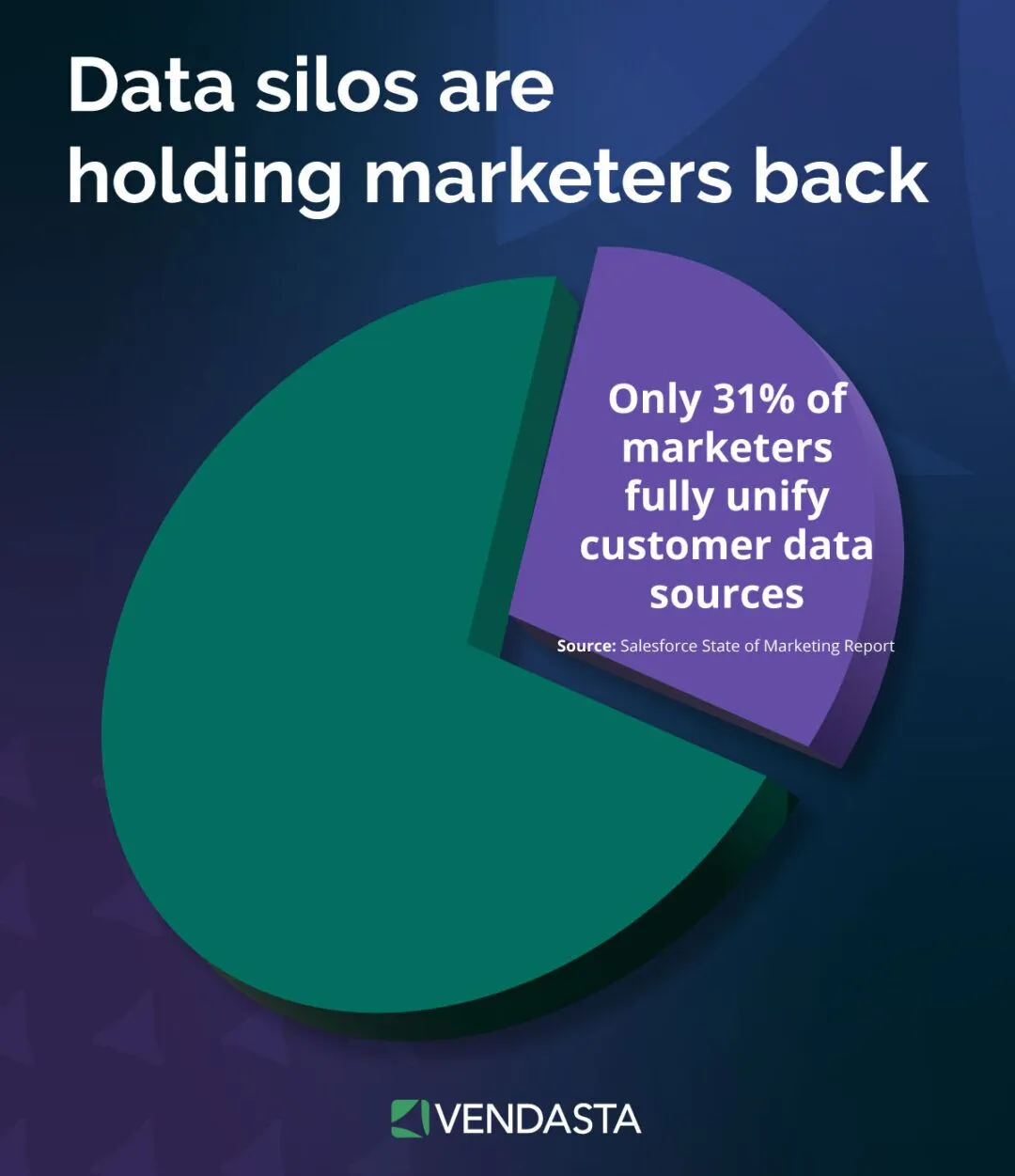
When customer information is scattered across disconnected systems, teams struggle to deliver a consistent, personalized experience. With client management software, all your client data—contact details, communication history, behavior insights, and service preferences—is unified in one centralized platform.
This unified view empowers your business to meet today’s top customer expectations:
- Instant response times
- Seamless omnichannel experiences
- Hyper-personalized communication
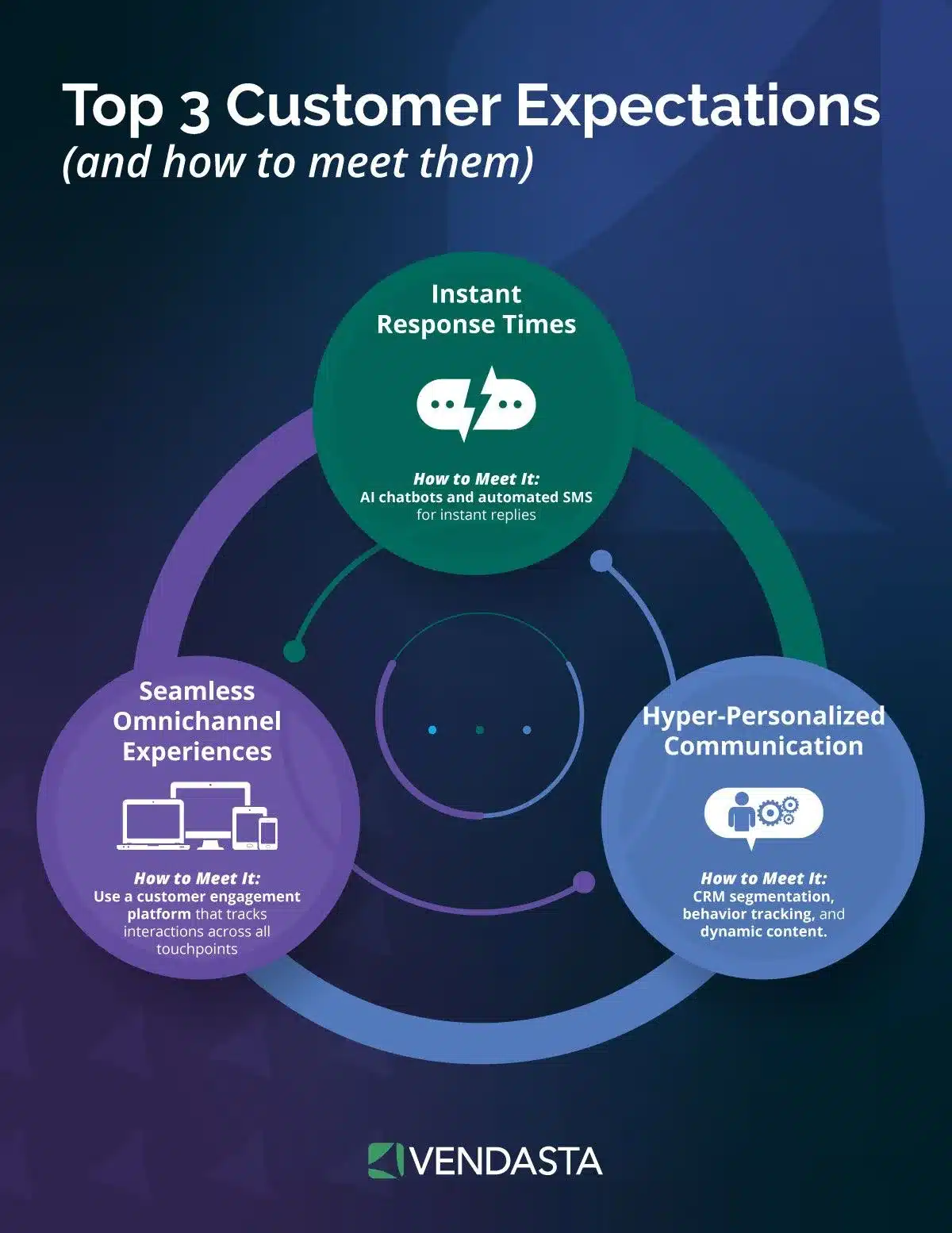
In short, client management software bridges the gap between disjointed data and the high-touch service your clients expect. It doesn’t just organize information—it powers exceptional customer experiences at scale.
Here is a list of features commonly found in contact management tools:
- Centralized Information Access: Access a client’s complete history from a single platform, eliminating the need to search multiple tools and improving efficiency.
- Stronger Personalization: Deliver tailored service by referencing past conversations, project details, and preferences. Personalization fosters loyalty and enhances client satisfaction.
- Improved Team Collaboration: Share a unified knowledge base among team members to ensure everyone stays informed about client updates, enabling seamless coordination.
- Faster Communication: Instantly access client details to respond to inquiries, send follow-ups, or provide updates efficiently, boosting team productivity.
- Historical Data for Better Decisions: Analyze interaction history to understand client behavior, identify trends, and make informed decisions that strengthen relationships and drive growth.
2. Task and Project Management: Stay on Track and Deliver Results
Managing client projects effectively requires handling various components, such as assignments, deadlines, updates, and approvals. Without the right tools, it’s easy for details to slip through the cracks, leading to missed deadlines, reduced productivity, and dissatisfied clients. This is where a robust task and project management system becomes indispensable.
Here are the essential features to look for in a project management tool:
- User-Friendly Interface: A platform that’s intuitive and easy for all team members to use effectively.
- Customization Options: Tools that can be tailored to fit your workflow, project type, and industry-specific needs.
- Integrations: Seamless compatibility with other software, such as communication apps, time trackers, and CRMs, to streamline processes.
- Scalability: The ability to grow with your team and accommodate increasingly complex projects as your needs evolve.
Pro Tip: Boost your agency’s productivity with Vendasta’s Task Manager. Eliminate repetitive tasks, track projects at every stage, and streamline communication with your team and clients—all within a single, unified platform.
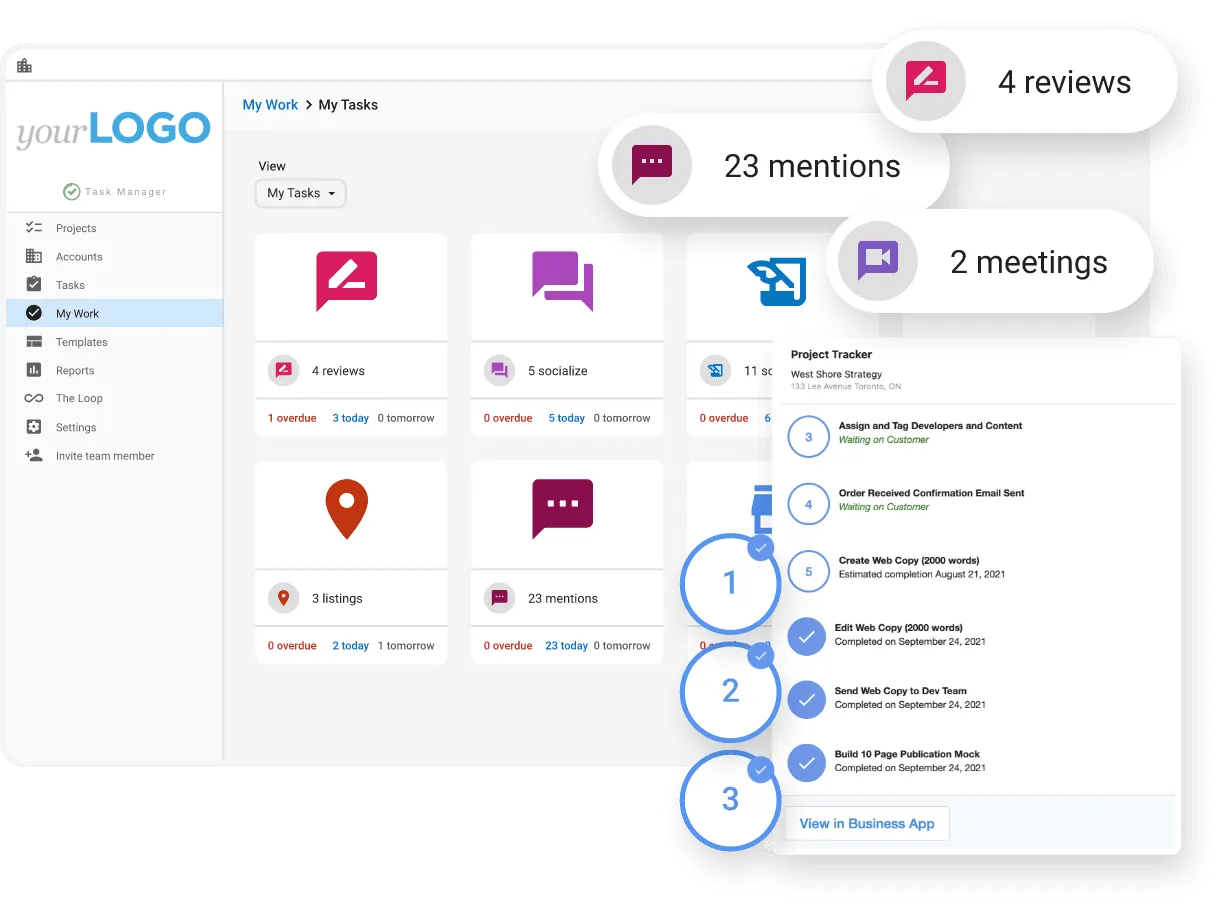
3. Lead Management: Nurture Opportunities Like a Pro
For marketing agencies and service providers, every lead represents a potential long-term client. But without the right systems in place, promising opportunities can slip through the cracks. That’s where robust lead automation in client management software comes in.
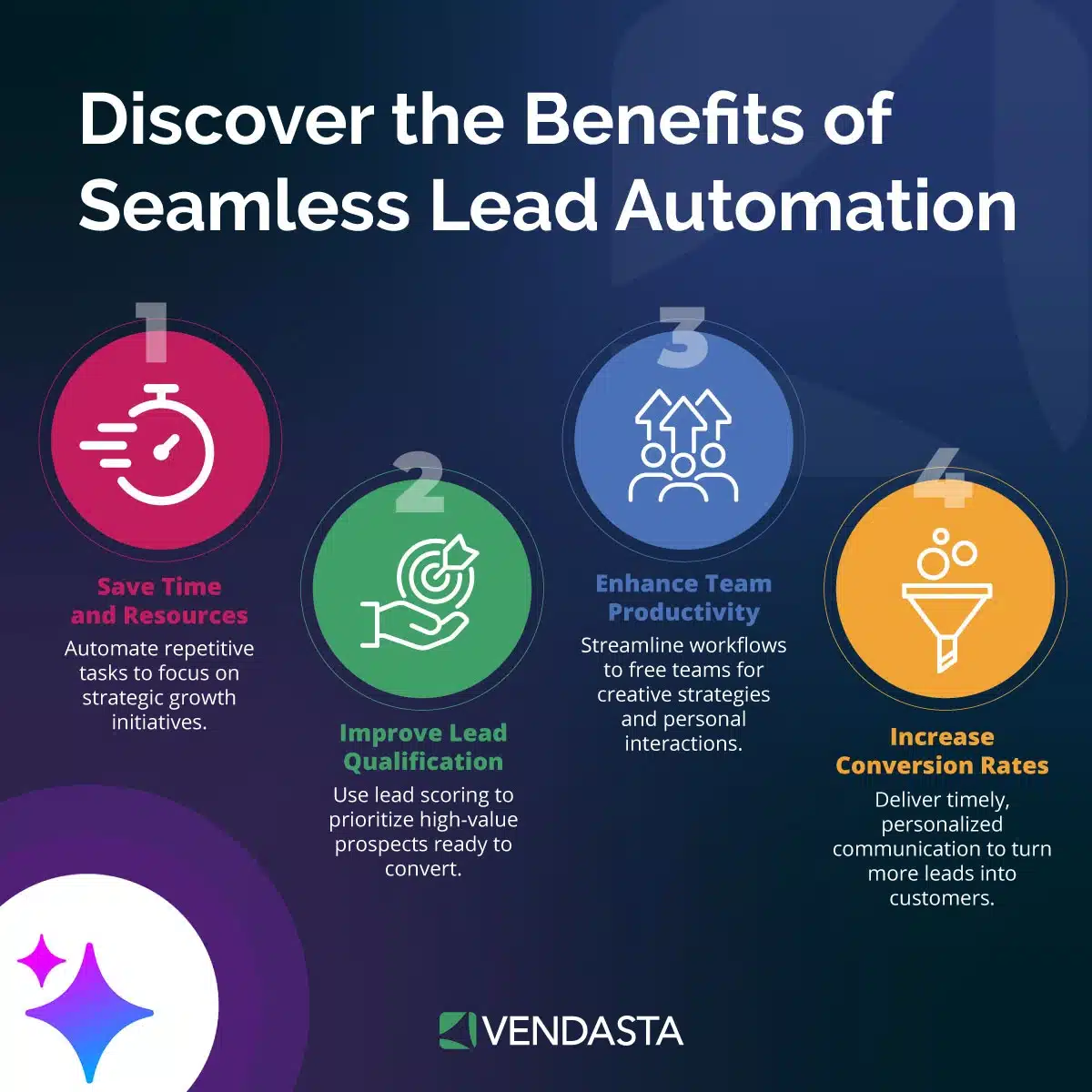
The best solutions don’t just track leads—they turn your pipeline into a predictable growth engine. From capturing inquiries to automating follow-ups, surfacing the hottest prospects, and nurturing leads, client management software gives your team full visibility and control over the sales journey.
Look for these critical lead management features to maximize conversion and efficiency:
- Lead Capture Tools: Seamless integration with forms, landing pages, and social media platforms.
- Pipeline Visualization: Intuitive dashboards that show the status of all leads at a glance.
- Workflow Automation: Tools to streamline repetitive tasks and follow-ups.
- Customizable Lead Scoring: Tailor scoring systems to fit your business model.
- Analytics and Reporting: Detailed reports to monitor performance and make data-driven decisions.
- Integration Capabilities: Compatibility with CRM, marketing automation, and other tools you already use.
With the right software, lead management becomes less of a juggling act and more of a repeatable process that drives predictable growth—freeing your team to focus on what they do best: building relationships and closing deals.
4. Campaign Management: Power Up Your Marketing Efforts
For agencies managing marketing efforts, campaign management is a game-changer. The right software allows you to plan, launch, and analyze marketing campaigns all in one place. Whether it’s a social media blitz or an email newsletter, you can track performance metrics and fine-tune your strategies for maximum impact.
When choosing a campaign management tool, prioritize the following features:
-
- Unified Dashboard: Access all campaign details and metrics in one place.
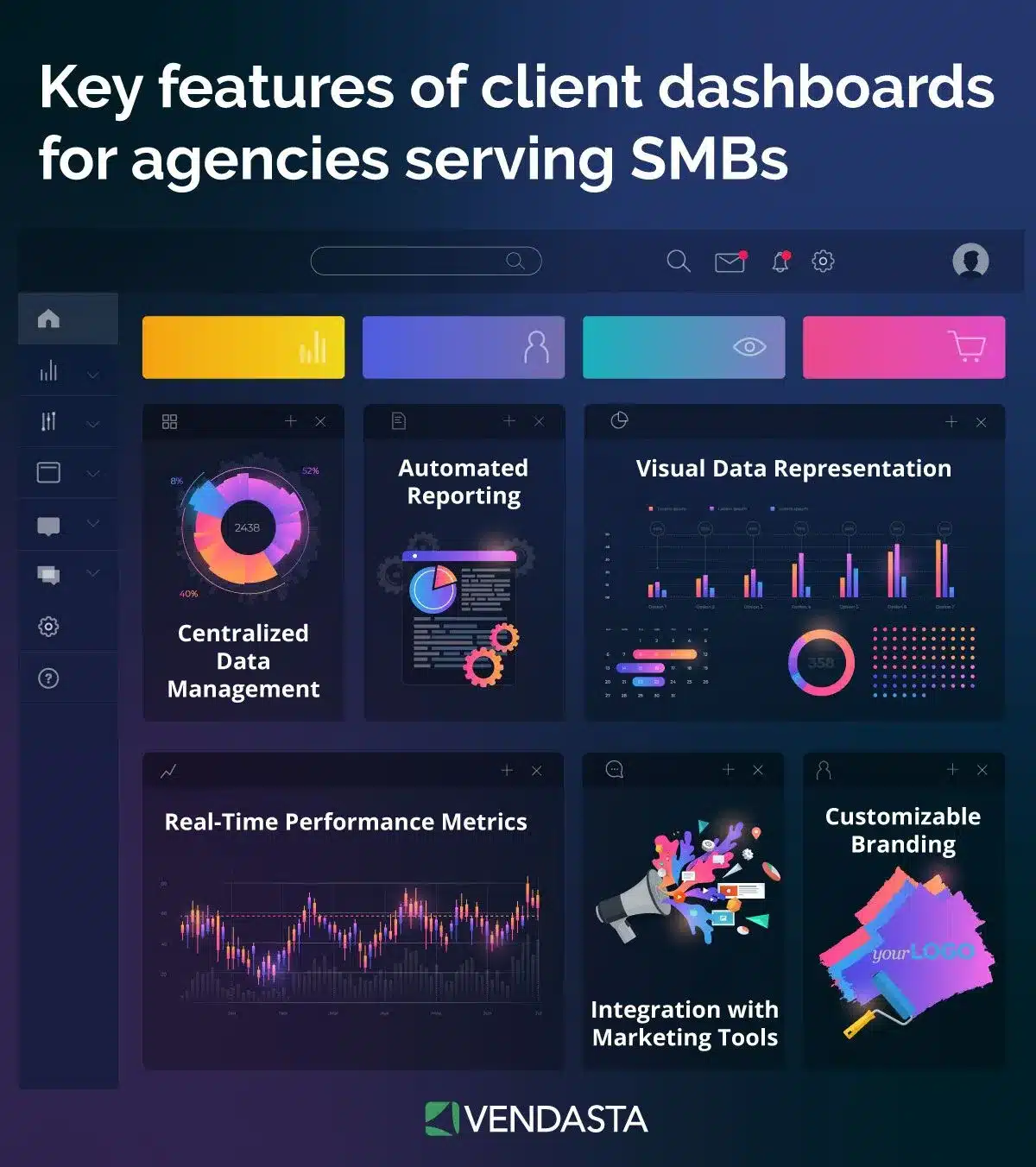
- Multi-Channel Integration: Manage social media, email, and ad campaigns seamlessly.
- Real-Time Analytics: Monitor performance metrics as campaigns unfold.
- Collaboration Tools: Enable teamwork with shared calendars, files, and updates.
- Automation Capabilities: Save time with automated scheduling, reminders, and reporting.
- Customizable Reporting: Generate tailored reports to share with clients or stakeholders.
5. Reporting and Analytics: Make Data-Driven Decisions
Knowledge is power, and white-label reporting tools put that power in your hands.
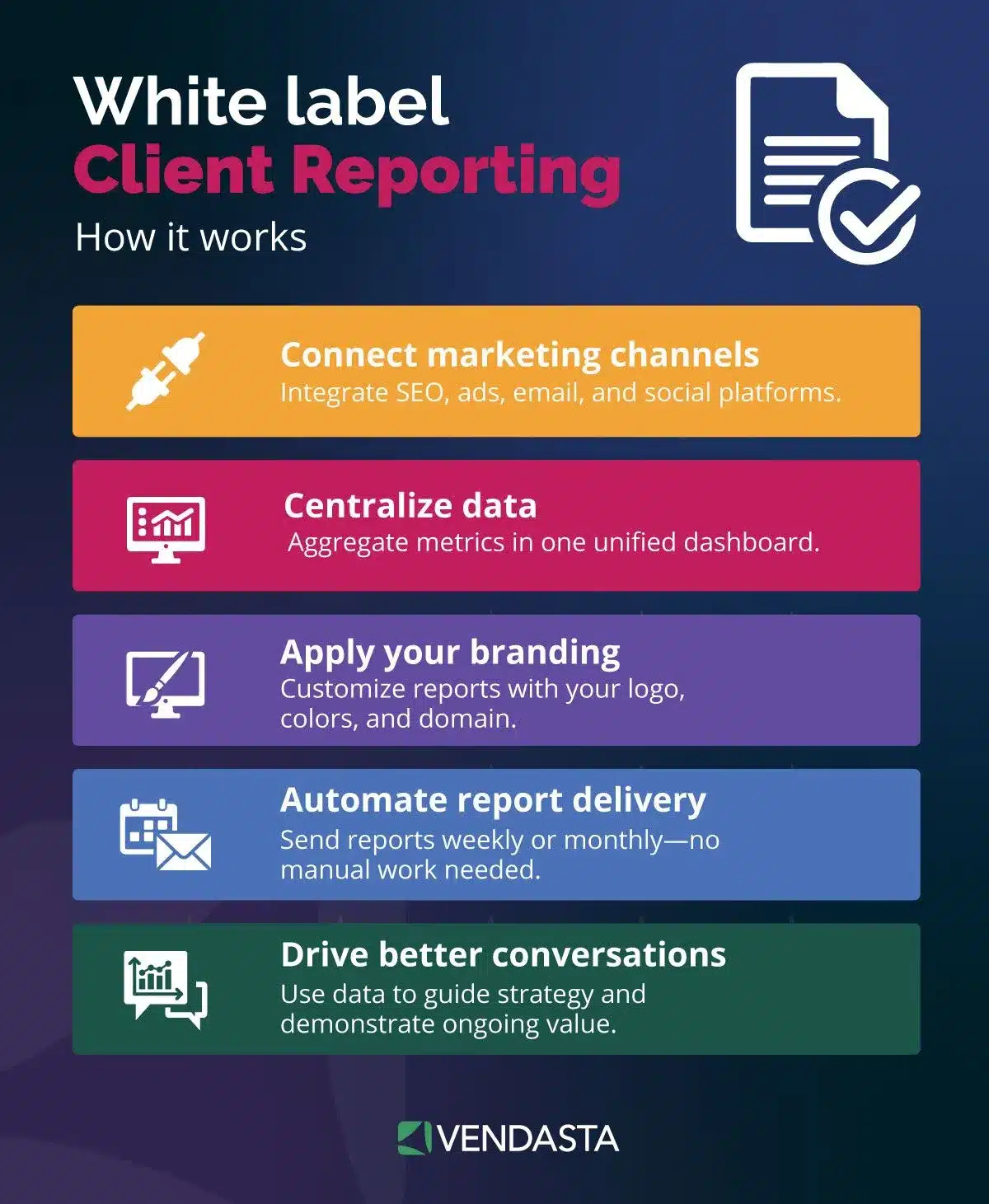
Robust reporting and analytics features let you track client activity, sales progress, and even marketing ROI. With clear insights, you can identify what’s working, address what isn’t, and make informed decisions to drive your agency forward.
The following are the features you must look for in a reporting and analytics tool:
- White-Label Customization: Brand the reports with your agency’s identity to maintain a professional and cohesive image.
- Real-Time Data Integration: Access up-to-date information across platforms and campaigns for timely decision-making.
- Ease of Use: Choose tools with intuitive interfaces and flexible options for customization.
- Automation Capabilities: Automate routine reporting tasks, such as weekly client updates, freeing up time for more strategic work.
- Cross-Channel Analytics: Ensure the tool can integrate data from multiple platforms, such as CRM systems, social media, and ad networks.
Pro Tip: Leverage Vendasta’s Executive Report, a white-label reporting software that lets you generate automated performance reports for multiple clients. This automated performance reporting tool allows you to generate detailed, professional reports for multiple clients with ease.
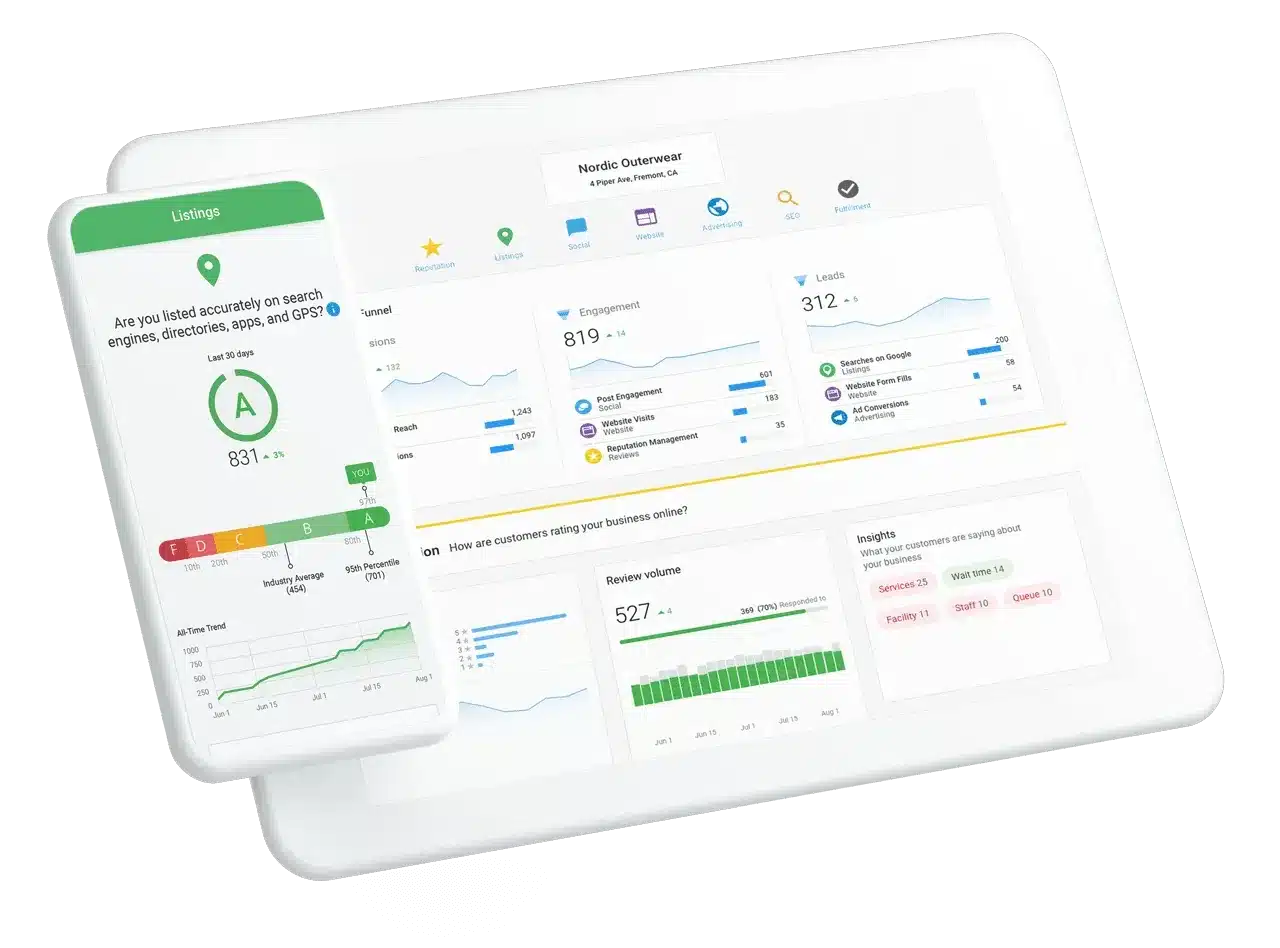
6. Integrations with Existing Tools: Make It All Work Together
Client management software doesn’t operate in a vacuum—it thrives when integrated with the broader ecosystem of business tools your team relies on. Whether you’re sending email campaigns, managing finances, tracking projects, or syncing calendars, having all systems working in concert ensures a smooth, scalable operation.
Here’s how great integration supports your business:
- CRM Synergy: Client management software complements traditional CRM systems by focusing on post-sale service delivery, onboarding, communication, and client retention. Together, they form a powerful cycle: CRMs manage prospects and conversion, while client management software takes over to ensure long-term satisfaction and upsell opportunities. Look for platforms that sync easily with your CRM to create a seamless handoff from sales to service.
- Pre-Built Integrations: Check if the software comes with ready-to-use integrations for the tools you already use. Popular software often includes built-in connectors for major platforms.
- Email Marketing and Automation: Ensure compatibility with email marketing platforms so you can trigger personalized campaigns directly from your client data.
- Accounting and Billing Tools: Integrations with tools like QuickBooks or Xero allow for streamlined invoicing, payment tracking, and financial reporting, reducing manual data entry and improving accuracy.
- Project Management Platforms: Connecting with project management tools enables tighter coordination between account management and internal teams, ensuring deadlines are met and deliverables stay on track.
- Open API Access: If pre-built integrations aren’t available, an open API allows your developers to create custom connections between the software and your existing tools.
- Ease of Setup: Look for integrations that are easy to set up, ideally requiring little to no technical expertise. Many platforms offer step-by-step guides or support to get you started.
- Two-Way Synchronization: Ensure the software supports two-way data syncing, meaning updates in one platform are reflected in the other and vice versa.
- Scalability: Choose a system with a broad range of integrations to accommodate new tools as your tech stack evolves.
The more connected your tools are, the more time your team saves—and the better your clients are served. When client management software becomes the connective tissue across your tech stack, you’re not just eliminating inefficiencies—you’re setting the stage for scalable growth.
Top Client Management Software Solutions
1. Vendasta
Vendasta is an AI-powered customer acquisition and engagement platform designed to help marketing agencies, franchisors, MSPs, or any businesses helping SMBs succeed acquire, manage, and grow client relationships effectively.
It offers a comprehensive suite of tools that streamline operations and enhance client satisfaction.
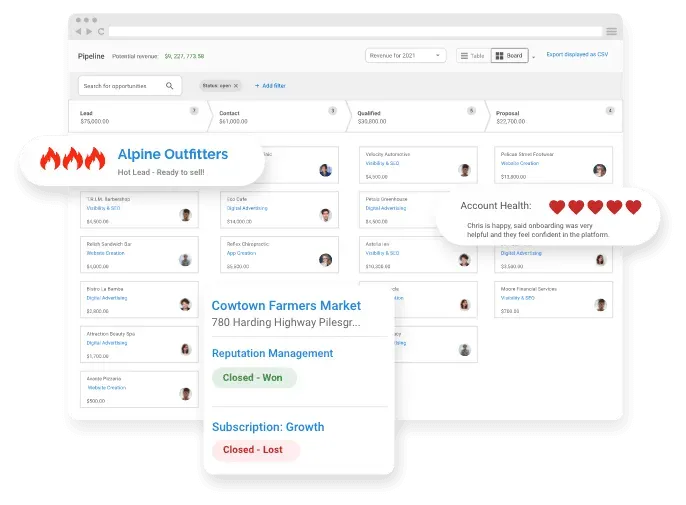
Key Features
- Contact and Lead Management: Centralizes client data, communication histories, and preferences, enabling personalized interactions and efficient lead tracking.
- Automated Client Reporting: Provides automated, proof-of-performance reports that keep clients informed and engaged, showcasing the value delivered.
- Campaign Management and Analytics: Facilitates the creation, execution, and analysis of marketing campaigns, offering insights into performance metrics and return on investment.
- Advanced AI Tools and White-Label Solutions: Utilizes AI to automate tasks such as review management and social media posting, and offers white-label CRM options to reinforce your agency’s branding.
- Integration with Third-Party Tools: Seamlessly connects with platforms like QuickBooks, Zapier, and Google Workspace, ensuring smooth workflows and data consistency.
By consolidating these features into a single platform, Vendasta empowers agencies to enhance efficiency, strengthen client relationships, and drive business growth.
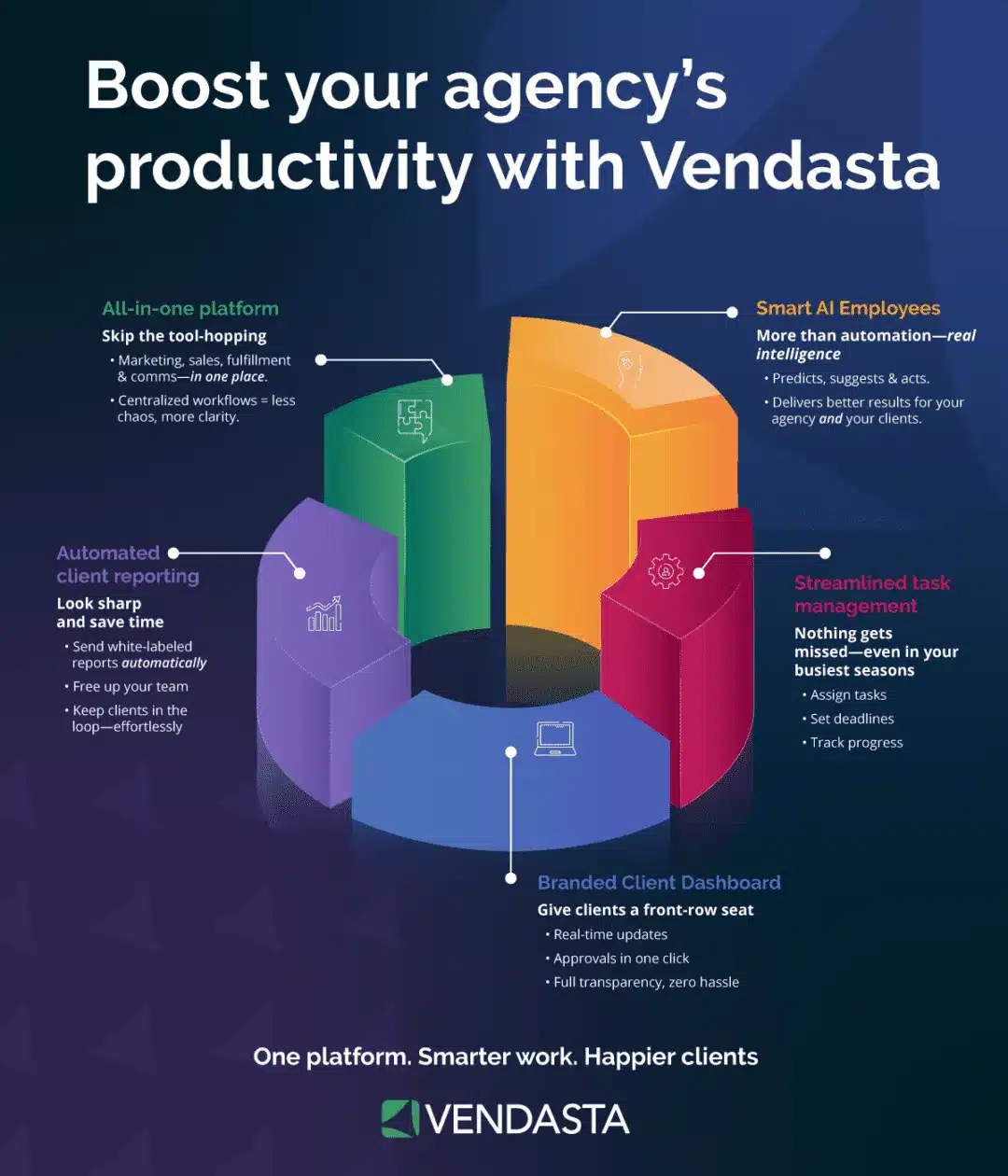
Pros
Vendasta’s client management software is purpose-built for businesses that serve small and medium-sized clients at scale.
One of its standout strengths is its all-in-one platform approach—combining sales CRM, task management, communication tools, and marketing automation under a single login.
This eliminates the need for multiple subscriptions and reduces the friction of disconnected systems.
It’s particularly strong in white-labeling capabilities, making it ideal for agencies that want to maintain their brand throughout the client experience.
Real-time collaboration tools, automated reporting, and integrated product catalogs also streamline service delivery and client communication.
Cons
While Vendasta offers impressive breadth, its depth in some specific areas (like advanced sales forecasting or granular project management) may not match specialized tools.
New users might face a learning curve due to the platform’s wide range of features.
Additionally, smaller businesses or solopreneurs who don’t require a white-label client portal or full-scale automation suite may find it more powerful than they need.
Integration with niche third-party tools may also require custom API work depending on your existing tech stack.
Ideal Use Cases for Vendasta
Vendasta’s client management software is a top choice for marketing agencies, franchises, and service providers that manage multiple clients or locations, and want to deliver consistent, branded services at scale.
It’s especially valuable for businesses offering digital marketing, reputation management, website services, or advertising to SMBs.
Franchisors benefit from the centralized visibility it provides across local operators, while agencies love its automated onboarding, fulfillment, and renewal workflows.
If your team juggles dozens (or hundreds) of clients and values operational efficiency, revenue growth, and client retention, Vendasta delivers the structure and automation you need to thrive.
2. Salesforce
Salesforce is a leading customer relationship management (CRM) platform that empowers businesses to streamline operations and enhance client relationships. Its comprehensive suite of tools is designed to cater to organizations of all sizes, offering scalability and flexibility.
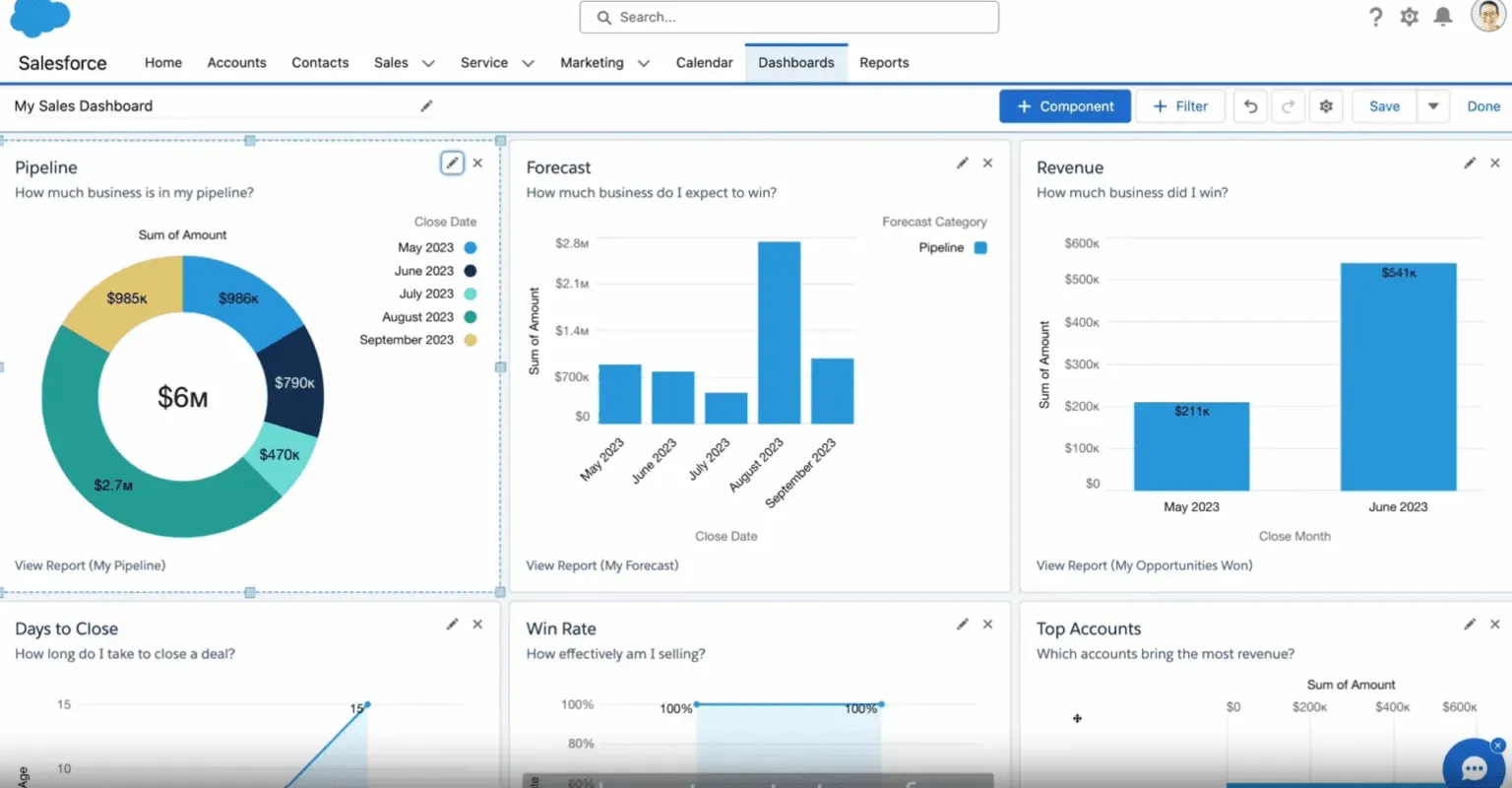
Key Features
- Advanced CRM Capabilities: Salesforce provides a unified platform to manage customer interactions, sales processes, and support services, ensuring a seamless experience across all touchpoints.
- AI-Driven Insights: With AI features, you can gain actionable insights into customer behavior, sales trends, and market opportunities, enabling data-driven decision-making.
- Scalability for Teams of All Sizes: Salesforce’s cloud-based infrastructure allows it to scale effortlessly, accommodating the evolving needs of growing businesses and large enterprises alike.
Pros
Salesforce is one of the most powerful and customizable CRM platforms on the market. Its biggest advantage is flexibility—users can configure virtually every aspect of the system to match complex workflows and business processes.
It offers robust lead and opportunity management, pipeline tracking, and advanced reporting features. Salesforce’s AppExchange provides access to thousands of integrations and add-ons, making it easy to tailor the platform to a wide range of use cases.
For agencies managing large sales teams or enterprise-level accounts, Salesforce provides deep visibility, automation, and scalability.
Cons
While Salesforce is highly capable, it comes with a steep learning curve and significant setup requirements—especially for smaller teams.
The platform can be overwhelming without a dedicated admin or developer, and costs can rise quickly as you add users or custom features.
For SMB-focused agencies or franchises without complex CRM needs, Salesforce may feel too heavy for day-to-day client management.
Additionally, although Salesforce supports integrations with many tools, aligning it smoothly with non-Salesforce ecosystems may require IT involvement or third-party connectors.
Ideal Use Cases for Salesforce
Salesforce excels in enterprise-level environments where sales operations are complex, data-driven, and tightly structured. It’s ideal for marketing agencies or franchises with large sales teams, multiple departments, and a need for highly customized workflows or in-depth analytics.
Businesses with long sales cycles or multi-touch buying journeys will benefit from Salesforce’s detailed pipeline and opportunity tracking. For organizations already invested in the Salesforce ecosystem or looking for a best-in-class CRM backbone to support aggressive growth, it’s a proven, scalable solution.
3. HubSpot CRM
HubSpot CRM is a comprehensive, user-friendly platform designed to help businesses efficiently manage customer relationships and drive growth. It offers a suite of free tools that cater to various aspects of customer engagement and sales processes.
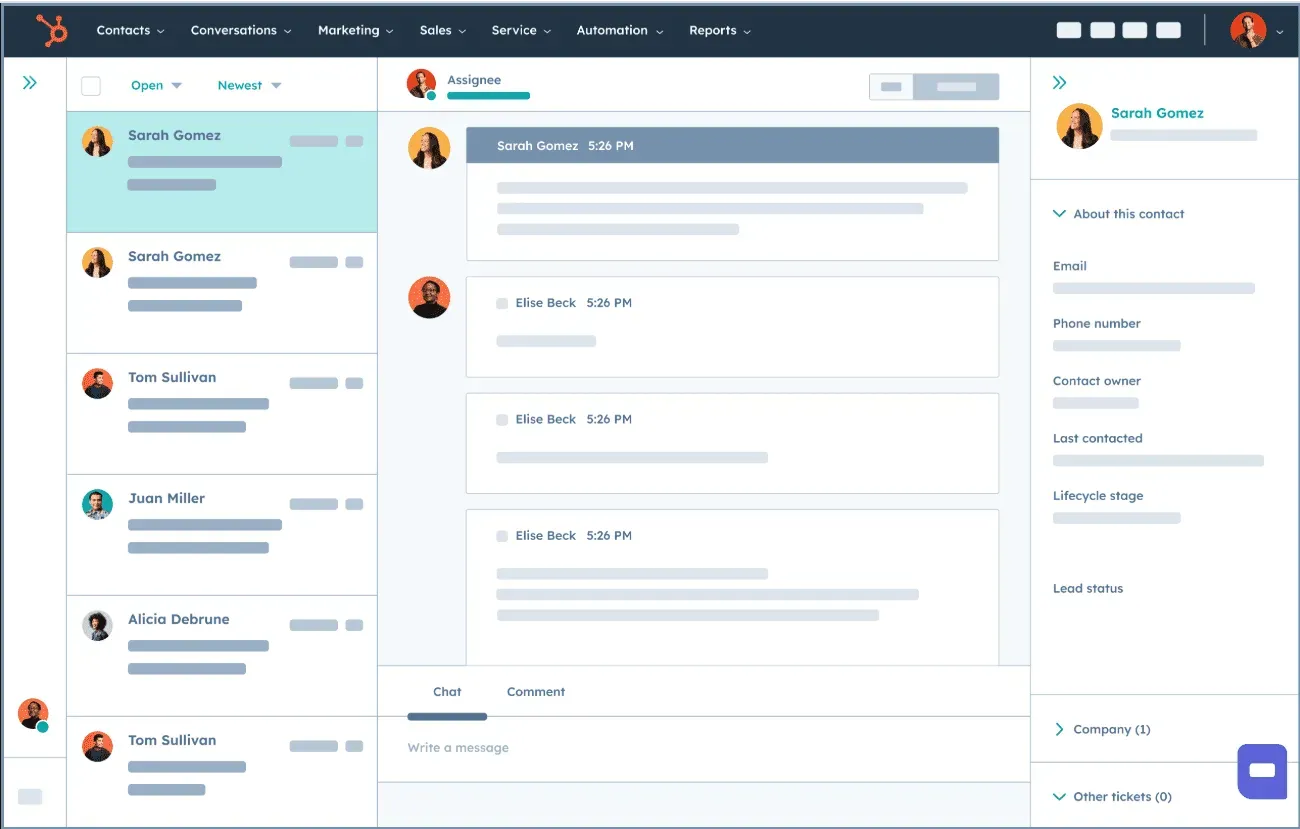
Key Features
- Free Tools for Lead Tracking and Email Marketing: HubSpot CRM provides tools that enable businesses to track leads and manage email marketing campaigns effectively. These tools help in capturing leads, organizing contact information, and executing targeted email campaigns to nurture prospects.
- Integration with Marketing Automation Workflows: The platform seamlessly integrates with marketing automation workflows, allowing businesses to automate repetitive tasks, segment audiences, and deliver personalized content.
Pros
HubSpot stands out for its user-friendly interface and seamless integration of marketing, sales, and service tools. It’s particularly attractive to marketing agencies thanks to its built-in content management, email marketing, and automation capabilities—all unified within a single platform.
HubSpot’s free CRM offers solid core features, while its paid tiers unlock powerful tools like lead scoring, behavioral tracking, and customizable workflows.
Its ease of use means agencies can get up and running quickly, and the HubSpot Partner Program provides resources and support specifically tailored for service providers helping SMBs grow.
Cons
While HubSpot’s all-in-one approach is convenient, its modular pricing structure can become expensive as your business scales or needs advanced features across multiple hubs (Marketing, Sales, Service, CMS, Operations).
Some customization options—especially on the free or lower-tier plans—are limited compared to platforms like Salesforce.
Additionally, while it offers strong functionality across many areas, it may not go as deep as specialized tools in areas like advanced analytics or enterprise resource planning. Businesses that outgrow HubSpot often cite the need for more granular reporting or deeper CRM configuration.
Ideal Use Cases for HubSpot
HubSpot is a smart fit for growing marketing agencies, franchises, and SMB-focused businesses looking for a modern, intuitive platform to manage client acquisition, onboarding, and ongoing communication.
It’s ideal for teams that want to unify their CRM with marketing automation, content strategy, and customer service without needing complex IT support.
Agencies serving local business clients benefit from HubSpot’s marketing automation features, reporting dashboards, and client segmentation tools—making it easy to show ROI, personalize outreach, and scale retention strategies.
For businesses that want quick wins and scalable growth without heavy technical overhead, HubSpot is a compelling choice.
Pro Tip: If you’re evaluating client management platforms and wondering how HubSpot stacks up against other options, check out our guide to the best HubSpot alternatives.
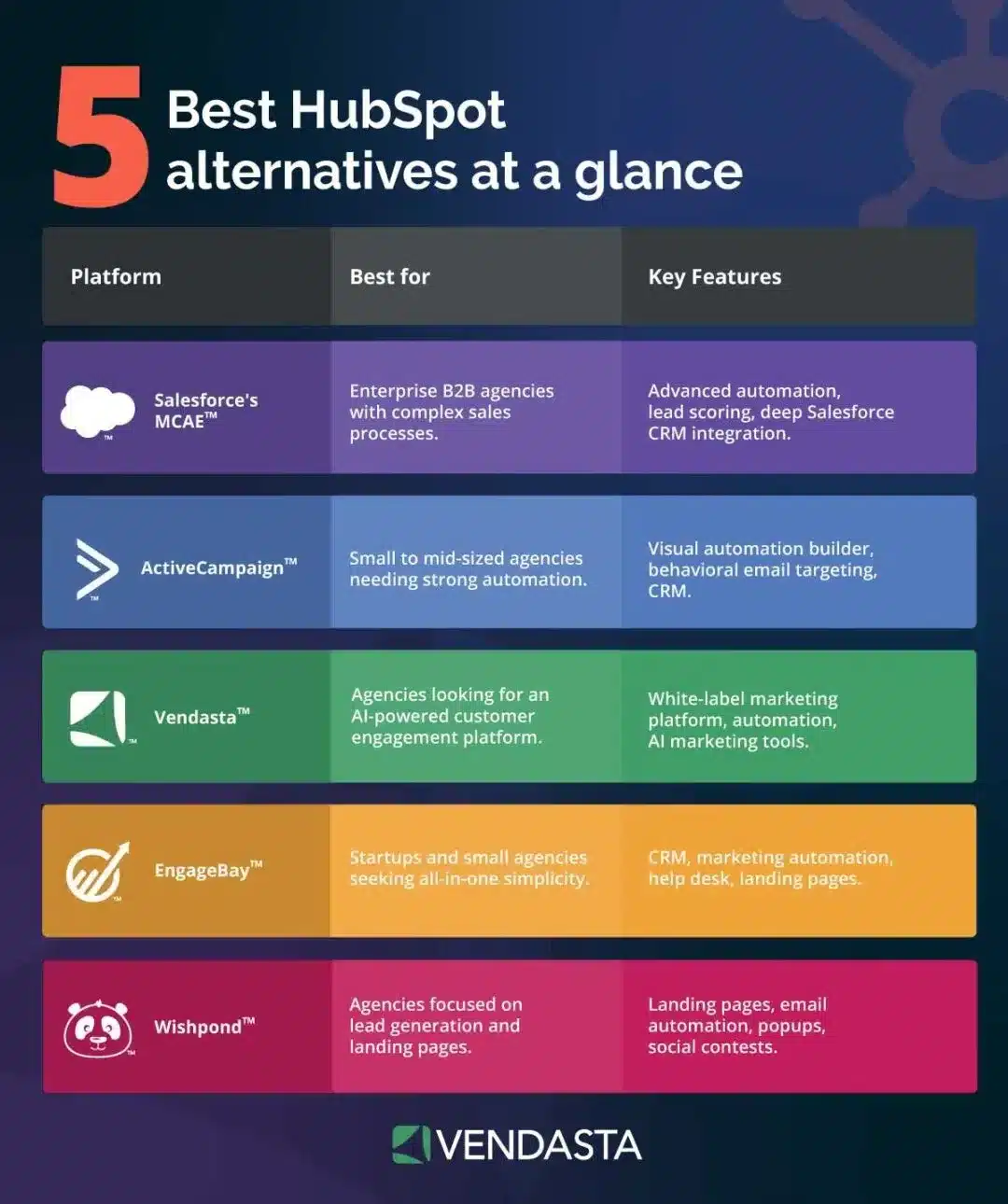
4. Zoho CRM
Zoho CRM is a versatile customer relationship management platform designed to cater to businesses of all sizes, offering a range of features to enhance sales and customer engagement.
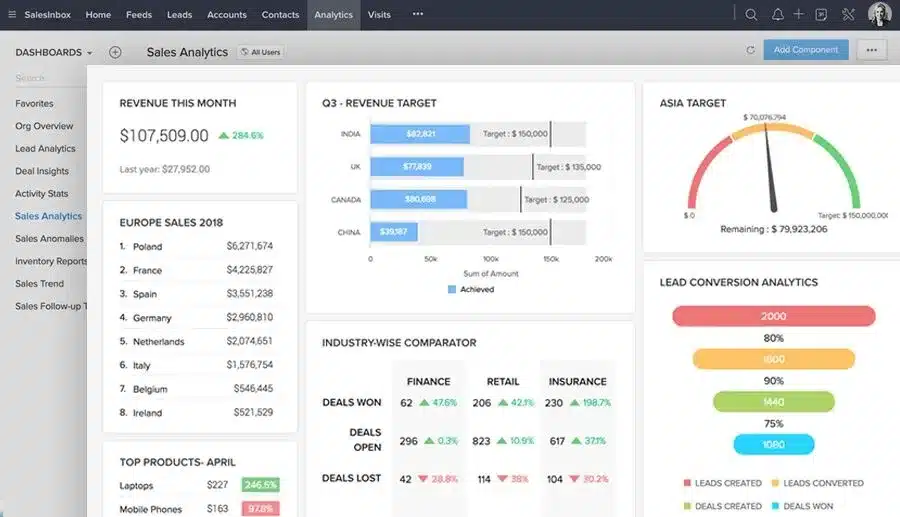
Key Features
- Customizable Dashboards: Tailor your dashboards to display key metrics and insights that matter most to your business, providing a personalized view of your sales and marketing performance.
- AI-Powered Sales Assistant (Zia): Leverage Zia, Zoho’s AI-driven sales assistant, to analyze sales patterns, predict anomalies, and suggest the best times to contact leads, thereby enhancing sales efficiency.
- Affordable Plans for Small Agencies: Zoho CRM offers cost-effective pricing plans suitable for small agencies, ensuring access to robust CRM tools without straining the budget.
Pros
Zoho CRM is a flexible and budget-friendly platform that offers a wide range of features suitable for small to mid-sized businesses.
It includes lead and contact management, workflow automation, analytics, and multichannel communication tools—all in an intuitive interface.
For agencies, its custom modules and AI-powered assistant (Zia) add value by helping teams automate repetitive tasks and gain insights from client interactions.
Zoho’s larger suite of business apps—such as Zoho Campaigns, Projects, and Books—makes it easy to extend functionality without leaving the ecosystem.
Cons
While Zoho CRM is powerful for its price, it can require significant customization to match specific agency or franchise workflows.
The interface, though improved over the years, may feel less polished or modern compared to platforms like HubSpot.
Some users report inconsistent support experiences, especially on lower-tier plans.
Additionally, businesses looking for deep native integrations with non-Zoho tools may need to rely on third-party connectors or API workarounds.
Ideal Use Cases for Zoho CRM
Zoho CRM is well-suited for cost-conscious agencies, franchises, or SMB-facing service providers that want robust CRM capabilities without enterprise-level costs. It’s ideal for businesses managing a high volume of leads and client accounts and who need automation, segmentation, and workflow tools to scale operations.
Franchises and multi-location businesses benefit from Zoho’s customization options and role-based access features, while agencies can take advantage of the broader Zoho ecosystem to manage projects, invoices, and campaigns—all from a single platform.
5. ClickUp
ClickUp is a versatile project management and productivity platform designed to centralize your work processes, enhancing team collaboration and efficiency.
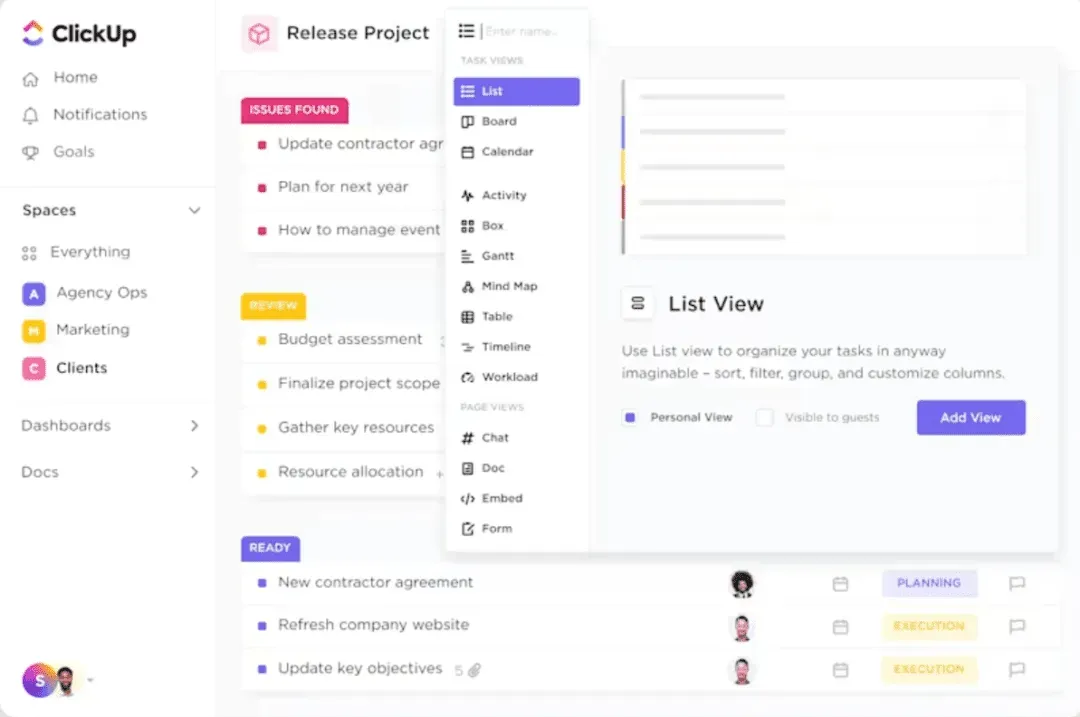
Key Features
- Comprehensive Task Management: ClickUp offers a flexible project management system that allows users to create, assign, and track tasks with multiple levels of subtasks, enabling granular project breakdowns. Tasks can be organized into lists, boards, calendars, and timelines, providing flexibility in how teams view and manage their work.
- Time Tracking and Collaboration Tools: The platform includes native time tracking features, allowing teams to monitor the time spent on tasks directly within the app. Additionally, ClickUp facilitates seamless collaboration through features like real-time editing, comments, and file sharing, ensuring all team members stay aligned and informed.
Pros
ClickUp is a highly customizable work management platform that excels in task organization, collaboration, and productivity tracking. For marketing agencies and SMB-focused teams, its flexibility is a major advantage—it allows you to build custom dashboards, automate workflows, and track progress across multiple clients or locations in real time.
ClickUp consolidates project management, time tracking, document sharing, and goal setting in one centralized hub, reducing the need for separate tools. Its intuitive user interface and powerful templates make it easy for teams to get started quickly and scale operations as they grow.
Cons
Despite its versatility, ClickUp’s vast feature set can be overwhelming for new users, especially without a clear onboarding strategy. Some advanced capabilities—like automation and integrations—may require a learning curve or technical support.
While it integrates with many popular tools, its native CRM features are limited compared to platforms purpose-built for client relationship management.
For agencies that need deep client-specific data management or external client portals, ClickUp may need to be paired with a CRM or client management platform for a complete solution.
Ideal Use Cases for ClickUp
ClickUp is ideal for marketing agencies, franchises, or operational teams managing high volumes of campaigns, deliverables, and client requests.
It’s particularly valuable for project managers and account teams who need a central place to assign tasks, monitor progress, and keep internal teams aligned.
Franchises and multilocation businesses can benefit from ClickUp’s role-based access and workspace organization, allowing different teams to operate independently while maintaining top-level visibility.
For SMB-focused businesses looking to streamline workflows and boost productivity without juggling multiple project tools, ClickUp is a flexible, scalable choice.
6. monday.com
monday.com is a versatile work operating system that enables teams to plan, track, and deliver projects efficiently. Its intuitive interface and customizable features make it suitable for organizations of all sizes.
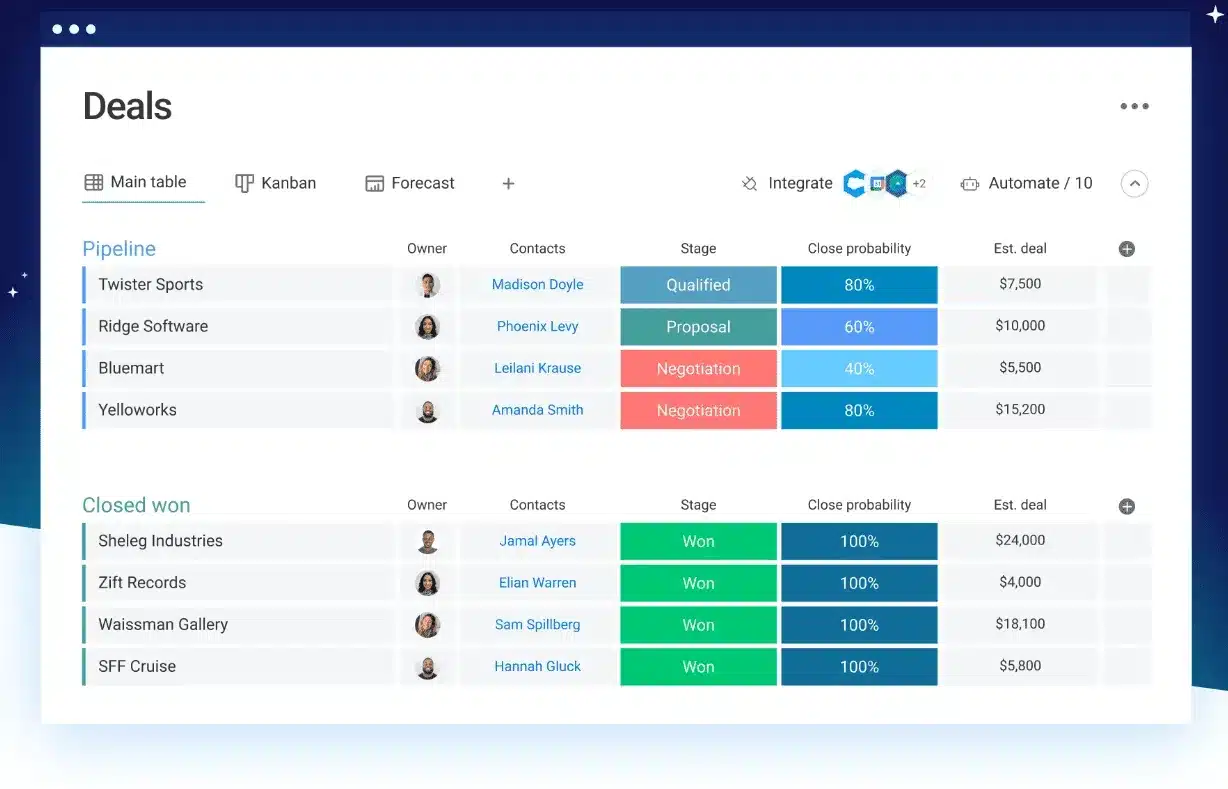
Key Features
- Visual Task Boards for Project Tracking: monday.com offers dynamic visual boards that allow teams to monitor project progress, assign tasks, and set deadlines, providing a clear overview of workflows.
- Customizable Workflows and Automation: Users can tailor workflows to their specific needs and automate repetitive tasks, enhancing efficiency and reducing manual errors.
Pros
monday.com is a visual and highly intuitive work management platform designed to simplify team collaboration and project tracking. Its flexible board-based system makes it easy to manage client tasks, timelines, approvals, and workflows—all from one place.
For marketing agencies and franchises, monday.com offers powerful automation, color-coded dashboards, and pre-built templates for campaign tracking, client onboarding, and content calendars.
It also supports integrations with popular tools like Slack, Google Workspace, HubSpot, and Zoom, helping teams consolidate their tech stack while improving operational efficiency.
Cons
While monday.com excels at project and task management, it lacks some of the deeper CRM and client-specific relationship tracking features found in dedicated client management platforms.
Its customization is strong for internal operations, but managing ongoing client communications, service histories, or invoicing may require integrations or external tools.
Additionally, as workflows become more complex, some users may find the platform’s scalability limited without investing in higher-tier plans or custom build-outs.
Ideal Use Cases for monday.com
monday.com is ideal for marketing agencies, creative teams, and franchises that need to streamline internal workflows and collaborate efficiently across departments or locations.
It’s particularly effective for teams that manage multiple client projects simultaneously and need visibility into task statuses, deadlines, and approvals.
Franchisors can also use it to coordinate national campaigns while giving local operators access to their own task boards.
For businesses serving SMBs, monday.com provides an excellent foundation for managing deliverables and staying organized, especially when paired with a client-facing CRM or service portal.
7. Nifty
Nifty is a comprehensive project management platform designed to streamline workflows and enhance team collaboration. It offers a suite of tools that centralize tasks, communications, and project timelines, making it an ideal solution for teams aiming to improve productivity and project visibility.
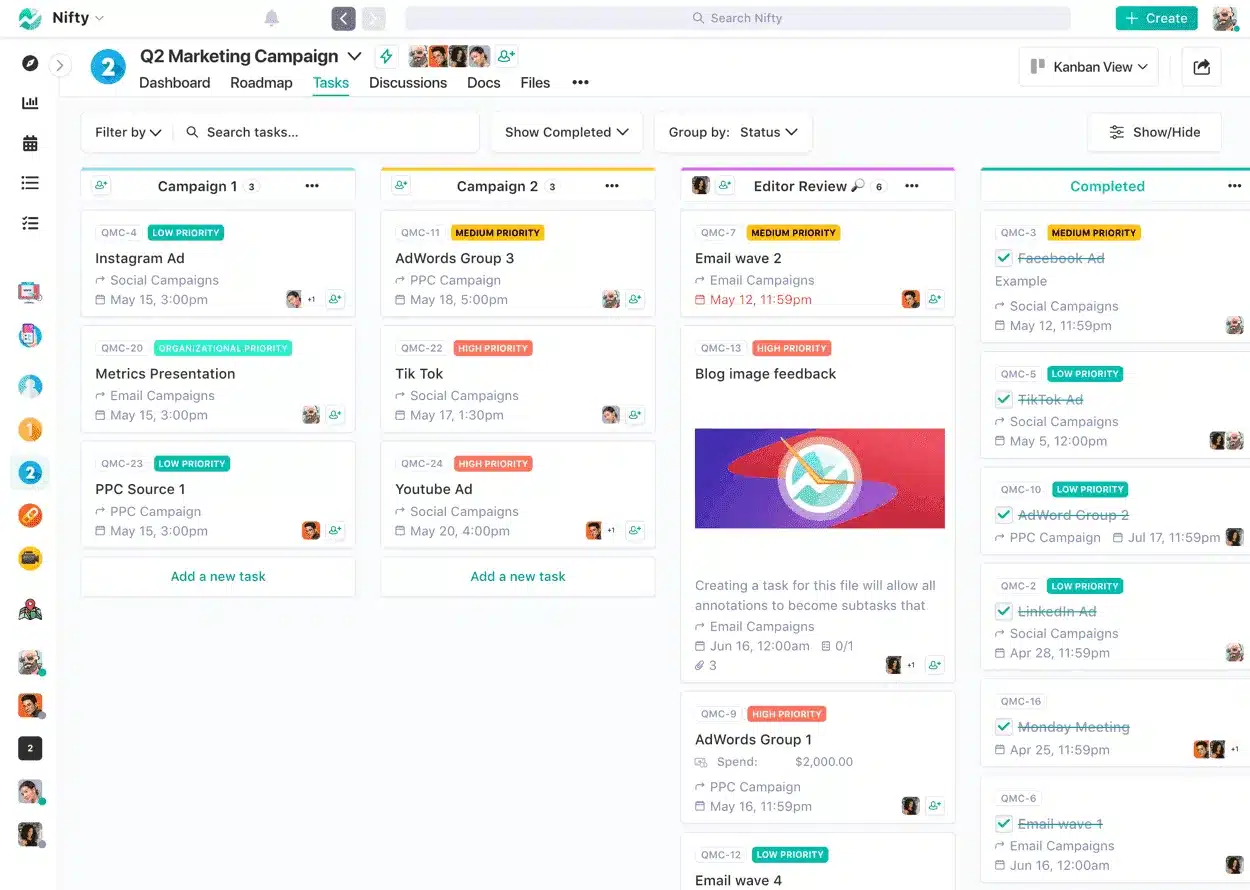
Key Features
- Client Portals for Real-Time Updates: Nifty provides dedicated client portals that allow clients to access project progress, milestones, and updates in real-time, fostering transparency and trust.
- Cross-Team Collaboration Tools: The platform facilitates seamless collaboration across different teams through features like task assignments, shared documents, and integrated discussions, ensuring everyone stays aligned and informed.
Pros
Nifty combines project management, collaboration, and communication into one unified platform.
For marketing agencies and franchises juggling multiple clients or campaigns, Nifty’s standout strength is its ability to manage timelines, tasks, documents, and chats in a single workspace.
Built-in time tracking, client portals, and milestone tracking help teams stay on schedule while keeping clients informed.
Its clean UI and ready-to-use templates make onboarding quick, and integrations with tools like Google Drive, Zoom, and Slack help streamline existing workflows.
Cons
While Nifty is a strong all-in-one platform, it may not offer the same depth of customization or advanced automation as more mature tools like ClickUp or monday.com.
Its CRM features are basic, making it less suitable for agencies needing robust client relationship tracking or complex sales workflows. Some users may find the reporting and analytics capabilities limited compared to platforms focused on data-heavy operations.
Businesses scaling rapidly may need to pair Nifty with additional tools to cover CRM, billing, or advanced marketing automation.
Ideal Use Cases for Nifty
Nifty is an excellent choice for small to midsized marketing agencies, creative teams, and franchises that prioritize ease of use, collaboration, and streamlined project execution.
It’s particularly useful for teams that want to bring clients into the project space—without overwhelming them—thanks to Nifty’s built-in client portal and simplified views.
Agencies serving SMBs can use Nifty to coordinate deliverables, track feedback, and centralize communication without jumping between apps.
For teams looking for a balance between simplicity and functionality, Nifty delivers a well-rounded solution.
8. Asana
Asana is a leading work management platform that enables teams to coordinate tasks and projects effectively, ensuring timely delivery and enhanced collaboration.
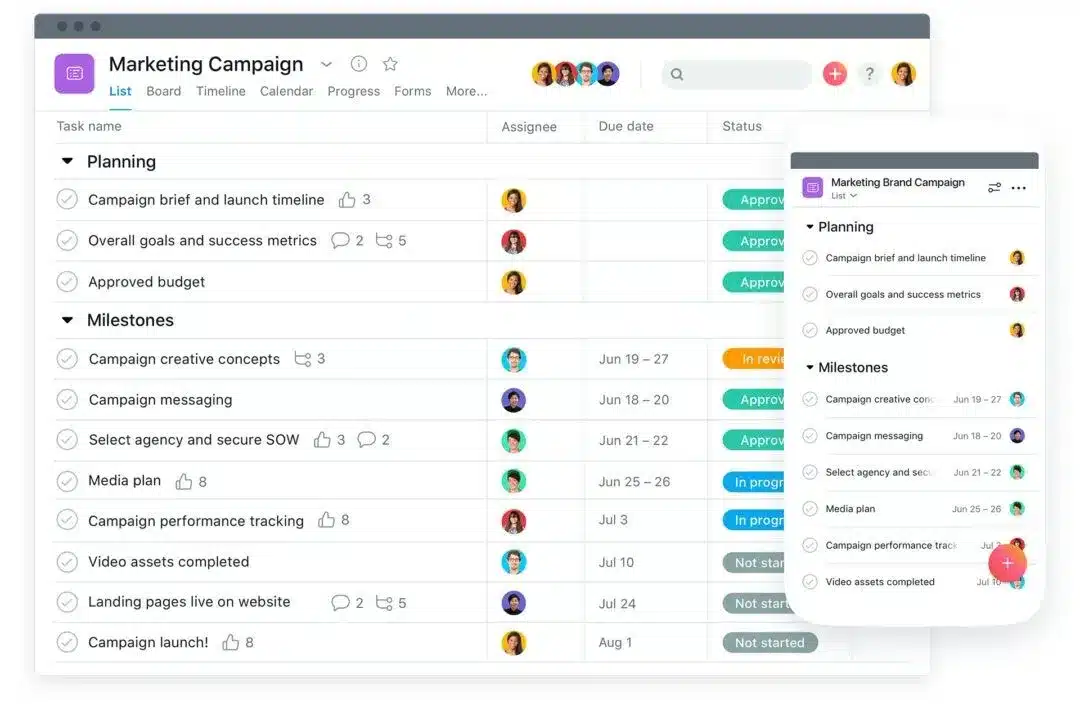
Key Features
- Project Management with Milestones and Deadlines: Asana allows teams to set clear milestones and deadlines, providing a structured approach to project progression and timely completion.
- Integration with 200+ Tools, Including Slack and Google Drive: It seamlessly integrates with a wide array of tools, such as Slack and Google Drive, facilitating a cohesive workflow across different platforms.
Pros
Asana is a well-established project and task management platform known for its clean interface and ease of use. It helps marketing teams stay organized with visual project timelines, kanban boards, calendars, and to-do lists.
For agencies and franchises managing recurring campaigns or client deliverables, Asana’s task dependencies, custom fields, and collaborative features make it easy to coordinate across teams and departments.
It also integrates with popular tools like Slack, Google Drive, Zoom, and Adobe Creative Cloud, helping streamline content production and communication.
Cons
While Asana excels at task and project tracking, it’s not designed to function as a full client relationship management (CRM) system.
It lacks built-in client portals, contact histories, or sales pipeline views—making it less suited for managing ongoing service relationships.
For agencies that need to track account communications, invoices, or client data in detail, Asana may need to be supplemented with a CRM or client management software.
Additionally, advanced features like timeline views and workload reporting are gated behind higher-tier plans.
Ideal Use Cases for Asana
Asana is ideal for marketing agencies, content teams, and franchises that need a clear structure for managing campaigns, creative production, and team tasks. It’s especially useful for businesses that operate in fast-paced environments and value accountability and visibility across projects.
Franchises can use Asana to manage localized initiatives under centralized oversight, while SMB-focused agencies can standardize onboarding, campaign planning, and client delivery workflows.
Asana shines in environments where operational efficiency and task clarity are top priorities.
9. Trello
Trello is a user-friendly project management tool that utilizes visual boards, lists, and cards to help teams organize tasks and collaborate effectively.
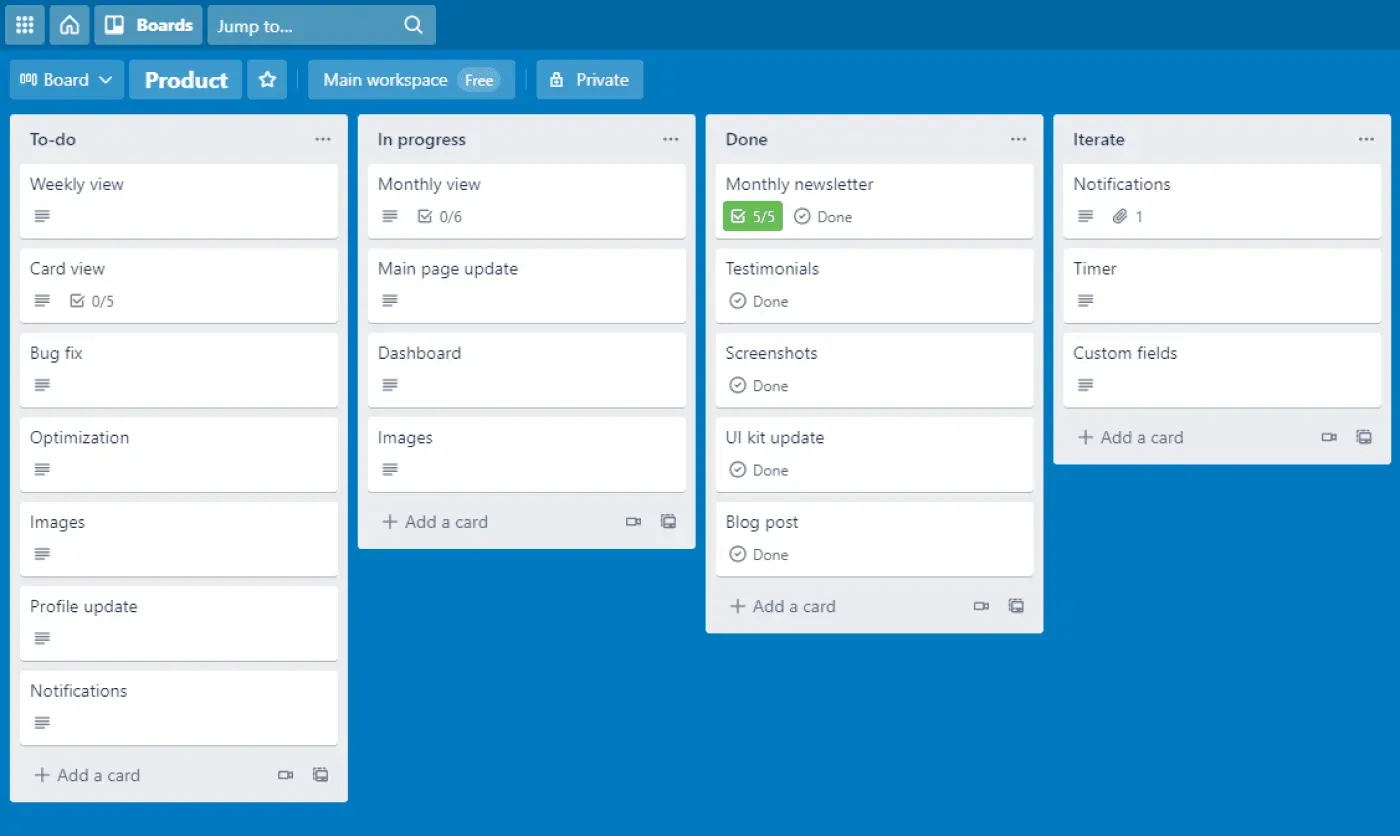
Key Features
- Kanban Boards for Task Management: Trello employs a Kanban-style system, allowing users to create boards for projects, lists for stages, and cards for tasks, providing a clear visual overview of progress.
- Easy Drag-and-Drop Interface: The intuitive interface enables users to move cards across lists effortlessly, facilitating quick updates and adjustments to workflows.
Pros
Asana is a well-established project and task management platform known for its clean interface and ease of use. It helps marketing teams stay organized with visual project timelines, kanban boards, calendars, and to-do lists.
For agencies and franchises managing recurring campaigns or client deliverables, Asana’s task dependencies, custom fields, and collaborative features make it easy to coordinate across teams and departments.
It also integrates with popular tools like Slack, Google Drive, Zoom, and Adobe Creative Cloud, helping streamline content production and communication.
Cons
While Asana excels at task and project tracking, it’s not designed to function as a full client relationship management (CRM) system.
It lacks built-in client portals, contact histories, or sales pipeline views—making it less suited for managing ongoing service relationships.
For agencies that need to track account communications, invoices, or client data in detail, Asana may need to be supplemented with a CRM or client management software.
Additionally, advanced features like timeline views and workload reporting are gated behind higher-tier plans.
Ideal Use Cases for Asana
Asana is ideal for marketing agencies, content teams, and franchises that need a clear structure for managing campaigns, creative production, and team tasks. It’s especially useful for businesses that operate in fast-paced environments and value accountability and visibility across projects.
Franchises can use Asana to manage localized initiatives under centralized oversight, while SMB-focused agencies can standardize onboarding, campaign planning, and client delivery workflows.
Asana shines in environments where operational efficiency and task clarity are top priorities.
10. Insightly
Insightly is a comprehensive customer relationship management (CRM) platform designed to help businesses build strong client relationships and streamline operations.
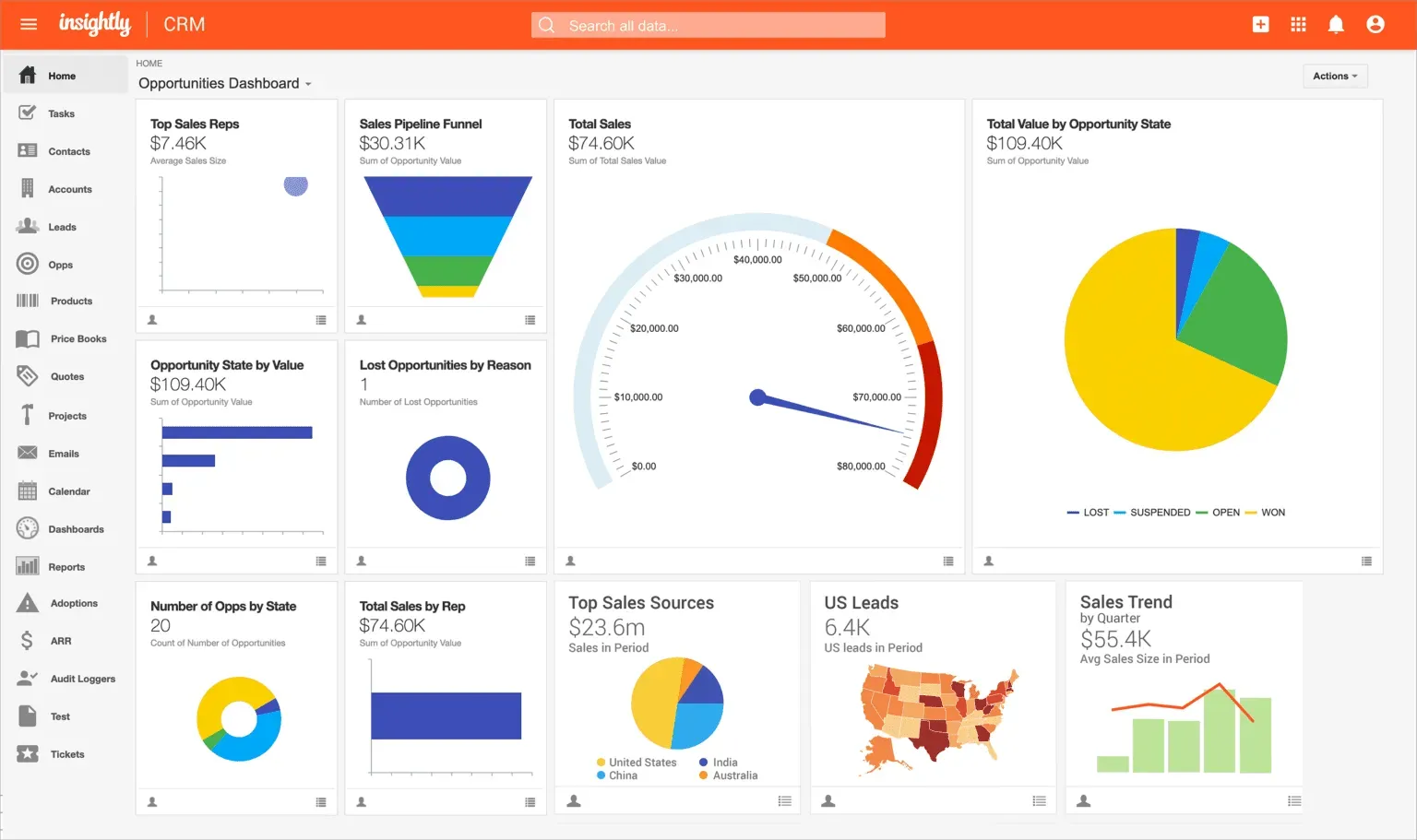
Key Features
- Built-in Email Marketing Capabilities: Insightly integrates CRM-powered email marketing, allowing users to design, send, and track email campaigns without the need for external applications.
- Project and Opportunity Management: The platform enables users to manage projects and sales opportunities effectively, providing tools to track milestones, assign tasks, and monitor progress, ensuring that projects are completed on time and that sales pipelines are optimized.
Pros
Insightly is a CRM and project management platform built for businesses that want to manage client relationships and project execution in one place.
It stands out for its strong contact management, pipeline tracking, and integrated project workflows—making it a solid fit for agencies and service-based teams handling long-term client engagements.
Insightly also offers built-in email templates, lead routing, and customizable dashboards.
Its integrations with Google Workspace, Outlook, QuickBooks, and Mailchimp support seamless collaboration across sales, marketing, and fulfillment teams.
Cons
While Insightly covers both CRM and project needs, it doesn’t go as deep in either area as more specialized tools. Its project management functionality, in particular, may feel limited compared to platforms like Asana or ClickUp.
Customization can also require a learning curve, and certain features—like advanced reporting or workflow automation—are locked behind higher-tier plans.
Businesses with complex marketing automation needs may find Insightly’s marketing module less sophisticated than dedicated platforms.
Ideal Use Cases for Insightly
Insightly is ideal for marketing agencies, consultants, and service-driven businesses that need an all-in-one system to manage sales opportunities, contacts, and project delivery.
It works particularly well for SMB-focused teams that value having client relationship data and post-sale workflows housed in a single solution.
Franchises and multi-location businesses can benefit from Insightly’s custom fields and role-based permissions to standardize operations across teams while tailoring data access.
For growing organizations looking to bridge the gap between CRM and fulfillment without juggling multiple platforms, Insightly is a practical choice.
How to Choose the Right Client Management Software
Finding the perfect client management app can feel overwhelming with so many options available. But with a little strategy, you can pinpoint the solution that fits your agency like a glove.
Here’s a guide to help you make the right choice:
1. Assess Your Agency’s Needs
Start by looking inward—what are the specific pain points in your current operations?
- Are deadlines slipping through the cracks?
- Is client communication disorganized?
- Do repetitive tasks eat up valuable time?
Once you’ve identified your challenges, prioritize the features that directly address them. For example, if communication is a weak spot, look for tools with robust collaboration and email tracking. If time management is a hurdle, automation and scheduling capabilities might be your top picks.
2. Consider Features and Scalability
Think about where your agency is now—and where it’s headed. You need software that can grow with you.
- Can it handle more users as your team expands?
- Will it accommodate additional clients and projects down the road?
Scalability is key, but so is compatibility. Make sure the software integrates smoothly with your existing tools like email platforms, marketing software, or financial systems. A solution that plays well with others saves time and reduces headaches.
3. Evaluate Usability and Support
Let’s be real—no one wants to spend weeks learning how to use new software.
- Opt for tools with an intuitive interface that your team can pick up quickly.
- Look for tutorials, documentation, and user-friendly white-label client portals.
And don’t overlook customer support! Whether it’s live chat, phone assistance, or an extensive help center, knowing help is readily available can make all the difference when challenges arise.
4. Review Pricing and ROI
Cost is always a consideration, but don’t just focus on the price tag. Evaluate what you’re getting for your investment.
- Compare pricing plans to find one that fits your budget.
- Think about the return on investment: How much time and effort will the software save? Will it help you retain more clients or streamline your workflows?
A slightly pricier tool might be worth it if it offers features that deliver significant long-term benefits.
Choosing the right client management software isn’t just about checking off a list of features—it’s about finding a solution that aligns with your agency’s unique needs and helps you grow. With a thoughtful approach, you’ll land on a tool that simplifies your work, delights your clients, and sets you up for success.
Why Vendasta Leads the Pack in Client Management Software
For agencies navigating the complexities of managing multiple clients, scaling operations, and delivering measurable results, Vendasta stands out as the ultimate client management solution.
Let’s explore why Vendasta leads the pack:
Built Specifically for Agencies
Vendasta’s unique focus on agencies sets it apart from other platforms. Whether you’re managing a handful of clients or scaling to handle dozens, we offer tools that adapt to your needs.
- Agency-Centric Design: Vendasta understands the challenges agencies face, such as juggling marketing, sales, and fulfillment processes for multiple clients.
- Streamlined Workflows: The platform centralizes these processes, ensuring smooth coordination across teams and eliminating bottlenecks.
Comprehensive Feature Set
Contact and Lead Management
Vendasta’s centralized dashboard ensures you never lose track of client details or sales opportunities.
- Track Leads Effectively: Monitor prospects as they progress through your sales pipeline with ease.
- Automated Follow-Ups: Receive reminders to reach out, keeping communication timely and consistent.
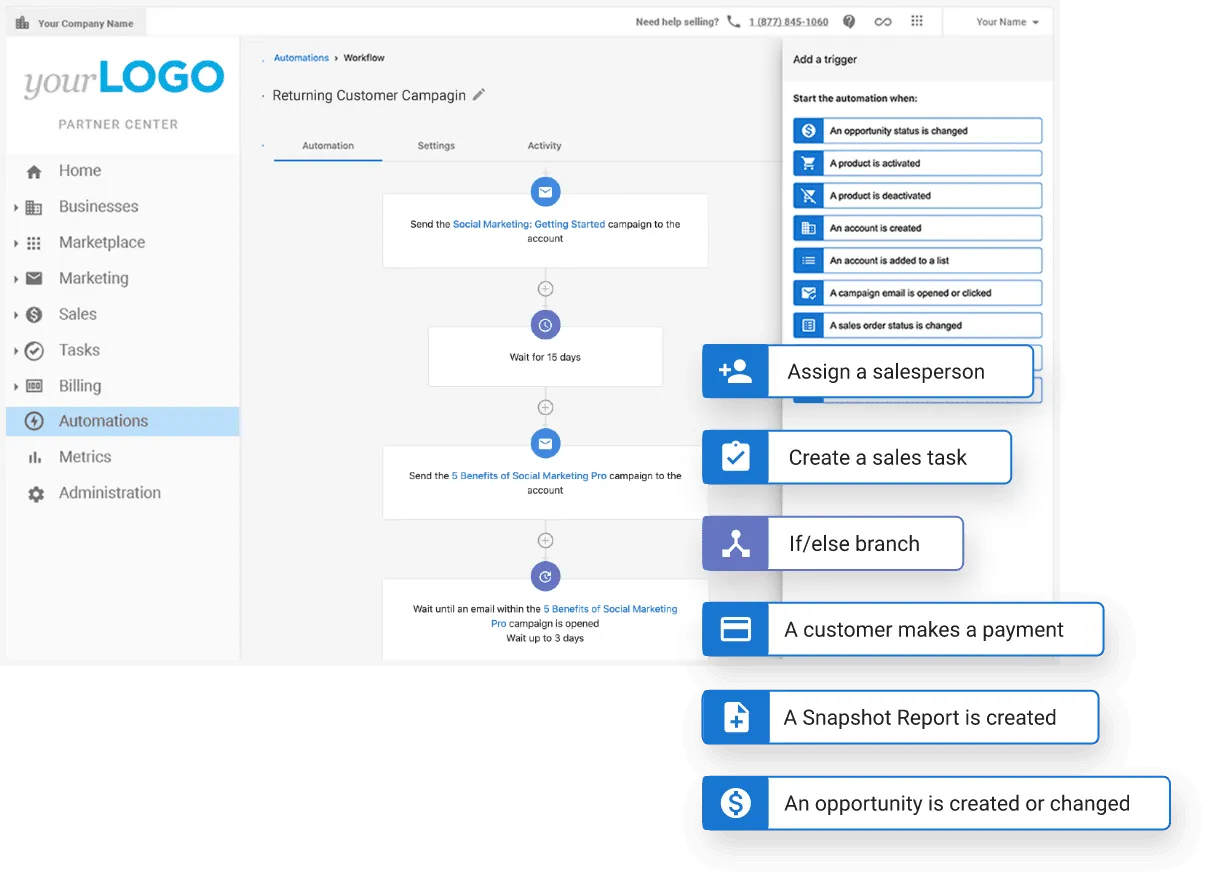
Task and Project Management
Stay on top of client projects with tools designed to keep teams aligned and productive.
- Task Assignment and Tracking: Assign responsibilities, set deadlines, and monitor progress—all in one place.
- Seamless Collaboration: Facilitate teamwork to ensure timely delivery of client campaigns and projects.
Automated Reporting
Show clients the value of your work without the hassle of manual reporting.
- Executive Reports: Provide detailed insights into campaign performance, ROI, and progress.
- Scheduled Updates: Automate delivery of reports, saving time while keeping clients informed.
Campaign Management and Analytics
Manage marketing efforts with tools built for effective execution and optimization.
- Launch and Track Campaigns: Plan, execute, and analyze marketing initiatives from a single platform.
- Real-Time Analytics: Monitor performance and adjust strategies on the fly for better results.
Integration with Leading Tools
Vendasta’s robust integrations with platforms like QuickBooks, Zapier, and Google Workspace ensure seamless workflows across your tech stack.
- Eliminate Redundant Data Entry: Synchronize information across tools to save time and reduce errors.
- Enhanced Efficiency: Simplify operations by connecting the systems you already use.
Scalability for Growing Agencies
Whether you’re onboarding your first client or scaling to hundreds, Vendasta grows with you.
- Support for Large Workloads: Manage an increasing number of clients and campaigns without compromising performance.
- Customizable Workflows: Adapt the platform to handle unique client needs, ensuring flexibility at every stage of growth.
User-Friendly Interface
Vendasta’s intuitive design ensures that teams of all technical expertise levels can quickly get up to speed.
- Easy Onboarding: Spend less time training and more time working.
- Encourages Adoption: Teams are more likely to embrace tools that are straightforward and efficient.
AI Workforce
Vendasta’s AI workforce revolutionizes the customer journey for local businesses by automating every step, from the first interaction to post-service feedback.
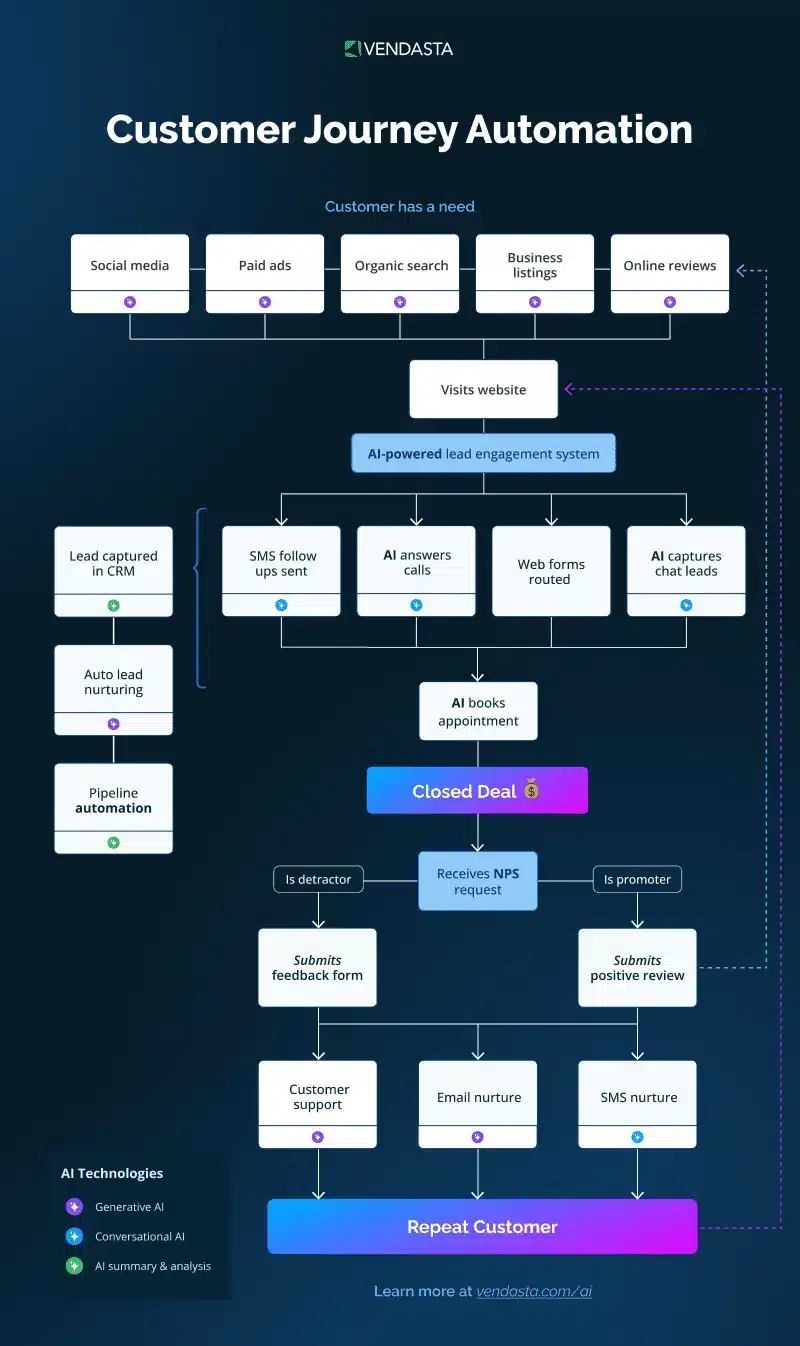
Seamlessly engage, nurture, and retain customers without lifting a finger, freeing up your time to focus on what matters most—growing your business.
By leveraging our AI, your agency can:
- Turn your complex data and instructions into easy-to-manage AI employees that work across the platform.
- AI workforce will help you with lead capture, automating customer communications, managing content, and many more.
- Manage your online reputation effortlessly by collecting Net Promoter Scores, requesting reviews from promoters, addressing feedback from detractors, and responding to positive reviews with care.
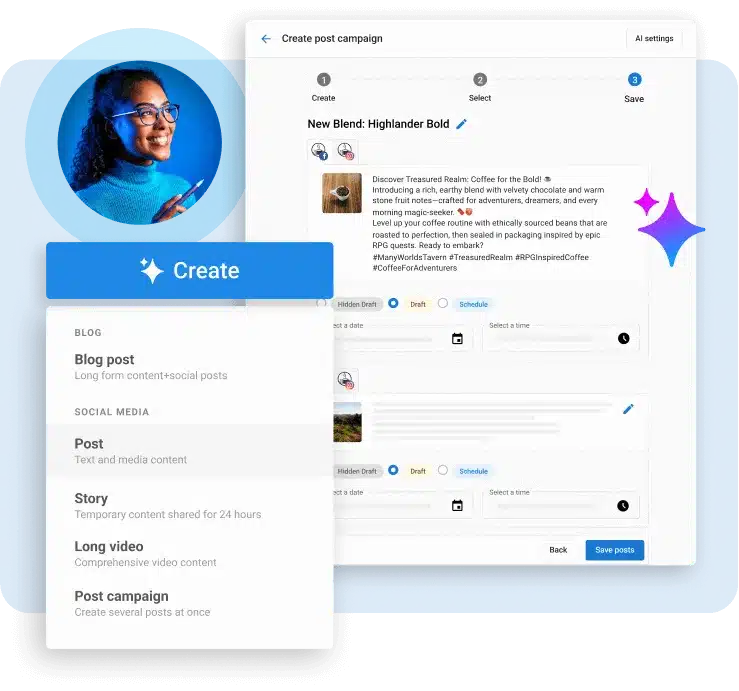
Vendasta’s combination of agency-focused design, powerful features, seamless integrations, and user-friendly interface makes it the leading choice for client management software.
How Businesses Leverage Client Management Software to Enhance Operations
Client management software isn’t just about organizing contacts; it’s a strategic tool that empowers businesses and agencies to scale, deepen client relationships, and drive growth.
Scaling High-Touch Service Models: The Blue River Digital Growth Story
For agencies and service-based businesses that pride themselves on personalized, high-touch client relationships, growth can often introduce a significant challenge: how to scale without losing that personal connection. Manual processes, disjointed reporting, and capacity limitations can quickly lead to inefficiencies and diluted client experiences.
Blue River Digital Growth, a digital agency, faced precisely these challenges as they expanded their operations. Their success was built on strong client relationships, but as their client base grew, maintaining that personal touch through manual efforts became unsustainable.
By partnering with Vendasta and leveraging their integrated platform, Blue River Digital transformed its client management approach. The software allowed them to:
- Streamline Client Onboarding and Communication: Automating initial setups and providing structured communication channels ensured a consistent, high-quality client experience from day one.
- Centralize Client Data and Interactions: All client information, communication history, and project details were consolidated in one place, making it easy for their team to access and understand each client’s unique needs.
- Enhance Reporting and Transparency: The platform enabled them to generate clear, automated client reports, offering transparency into campaign performance and ROI. This fostered greater trust and accountability.
- Identify Upsell and Cross-sell Opportunities: With a holistic view of client accounts and needs, Blue River Digital could proactively identify opportunities to offer additional services, leading to increased revenue per client.
Tangible Results Achieved:
The implementation of robust client management functionalities led to remarkable outcomes for Blue River Digital:
- 99% Client Retention Rate: A testament to their enhanced ability to meet and exceed client expectations.
- Significant Revenue Growth: They generated $240K in gross marketplace revenue, driven by improved client satisfaction and upsell success.
- Expanded Market Reach: The streamlined operations allowed them to efficiently serve clients across 33 states, demonstrating scalability.
The success stories like Blue River Digital Growth‘s demonstrate that client management software is an indispensable tool for businesses aiming to optimize operations, solidify client relationships, and achieve sustainable growth in a competitive landscape.
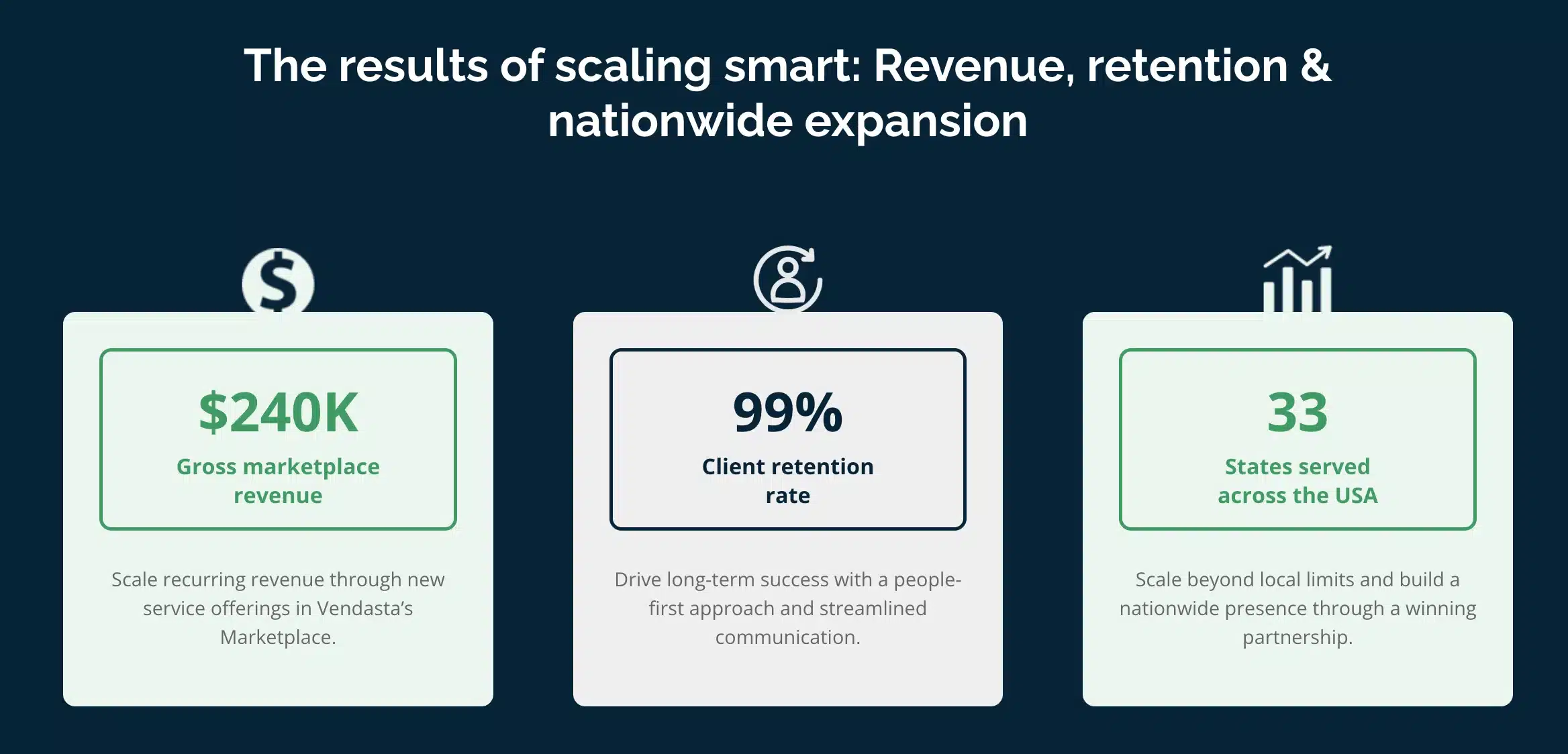
Elevate Operations with the Best Client Management Software
In today’s fast-paced business landscape, client management apps are no longer a luxury—it’s a necessity. These powerful tools transform the way agencies operate by enhancing organization, boosting productivity, and strengthening client relationships.
Why Client Management Software Matters
- Enhanced Organization: Centralized dashboards ensure teams have quick access to client information, project updates, and sales pipelines.
- Improved Productivity: Automating repetitive tasks like client reporting, follow-ups, and invoicing frees up valuable time for high-impact work.
- Stronger Client Relationships: Personalized communication, timely updates, and data-driven insights foster trust and loyalty among clients.
Vendasta: The Ideal Partner for Agencies
When it comes to client management software, Vendasta leads the way with features tailored specifically for agencies.
- Automation: Save hours with automated client reporting, reminders, and task management.
- Seamless Integrations: Connect your favorite tools like QuickBooks, Zapier, and Google Workspace for a unified workflow.
- Data-Driven Insights: Use Vendasta’s Executive Reports to showcase campaign performance and ROI, keeping clients informed and satisfied.
Vendasta doesn’t just help agencies manage clients—it empowers them to scale, deliver measurable results, and build long-term success.
Explore Vendasta’s features through a free demo and see how it can revolutionize the way your agency works. Book your demo now!
Client Management Software FAQs
1. What is client management software?
Client management software is a digital platform designed to help businesses manage and analyze all interactions and relationships with their clients. It centralizes client data, automates tasks, streamlines communication, and provides insights to improve client satisfaction, retention, and overall business growth. It’s often synonymous with Customer Relationship Management (CRM) software, particularly for service-based businesses or agencies.
2. How is client management software different from CRM software?
While often used interchangeably, “client management software” typically emphasizes the ongoing relationship, project delivery, and direct communication with existing clients, particularly in service or agency contexts. CRM (Customer Relationship Management) is a broader term that encompasses the entire customer journey, from lead generation and sales to post-sale support and retention. Many modern CRM solutions offer robust client management functionalities.
3. What are the key benefits of using client management software?
Implementing client management software offers numerous benefits, including:
- Improved Client Relationships: Centralized data leads to personalized interactions and better understanding of client needs.
- Enhanced Communication: Streamlined channels for emails, calls, and meeting notes ensure no detail is lost.
- Increased Efficiency & Productivity: Automation of repetitive tasks (e.g., scheduling, follow-ups, reporting) frees up time for more strategic work.
- Better Organization: All client information, project progress, and historical interactions are stored in one accessible location.
- Higher Client Retention: Proactive management of client needs and issues leads to greater satisfaction and loyalty.
- Data-Driven Decisions: Analytics and reporting provide insights into client behavior, project performance, and business health.
4. What essential features should I look for in client management software?
When choosing client management software, look for features such as:
- Contact Management: Centralized database for all client information.
- Communication Tracking: Logging emails, calls, and meetings.
- Project & Task Management: Tools to track project progress, deadlines, and assigned tasks.
- Document Management: Storing and sharing client-related files.
- Automations: Workflow automation for repetitive tasks.
- Reporting & Analytics: Dashboards and reports to monitor client health and performance.
- Integration Capabilities: Ability to connect with other tools like email, accounting software, and calendars.
- Client Portals: Secure portals for clients to access information, submit requests, or track progress.
5. Can client management software help with acquiring new clients?
Yes, indirectly. While its primary focus is often on existing clients, the insights gained from effective client management (e.g., successful project outcomes, high satisfaction rates) can lead to referrals and positive testimonials, which are crucial for attracting new business. Many platforms also integrate lead management and sales pipeline features to assist in the acquisition process.
6. Is client management software suitable for small businesses and freelancers?
Absolutely. Client management software is highly scalable. Many solutions offer affordable plans or even free tiers designed specifically for small businesses, startups, and freelancers. Even a basic system can significantly improve organization and professionalism, making it easier to grow and manage an expanding client base without being overwhelmed.
7. How difficult is it to switch to new client management software?
The ease of switching varies depending on the complexity of your current system (if any) and the new software. Most reputable client management software providers offer robust onboarding support, data migration tools, and training resources to ensure a smooth transition. It’s important to plan the migration carefully and allocate time for data import and team training.
8. How much does client management software cost?
The cost of client management software varies widely based on features, number of users, and the vendor. Pricing models typically include:
- Free Tiers: Limited features, suitable for very small businesses or individual freelancers.
- Per-User Monthly Subscriptions: Most common, ranging from $10-$100+ per user per month.
- Tiered Plans: Different feature sets at varying price points.
- Enterprise Solutions: Custom pricing for large organizations with advanced needs. Always consider the total cost of ownership, including potential add-ons, training, and support.


